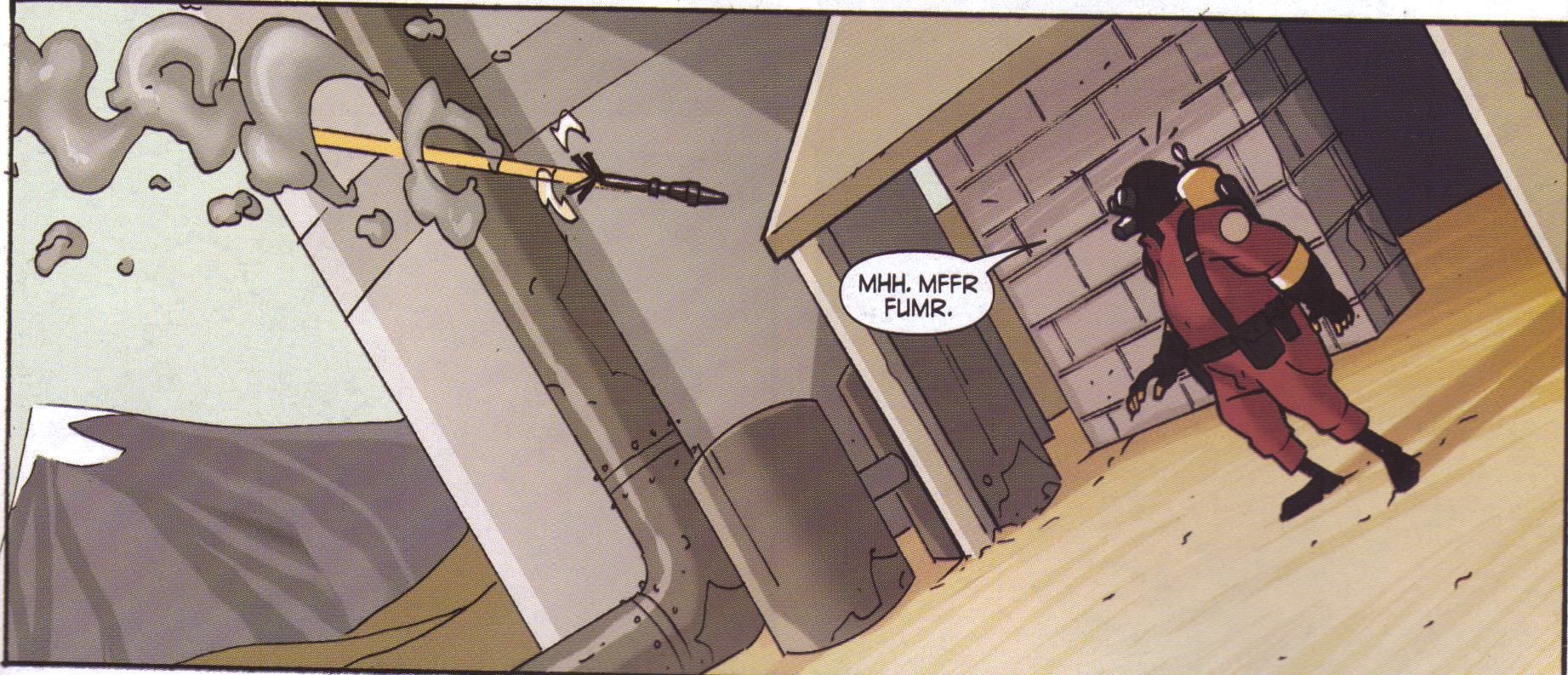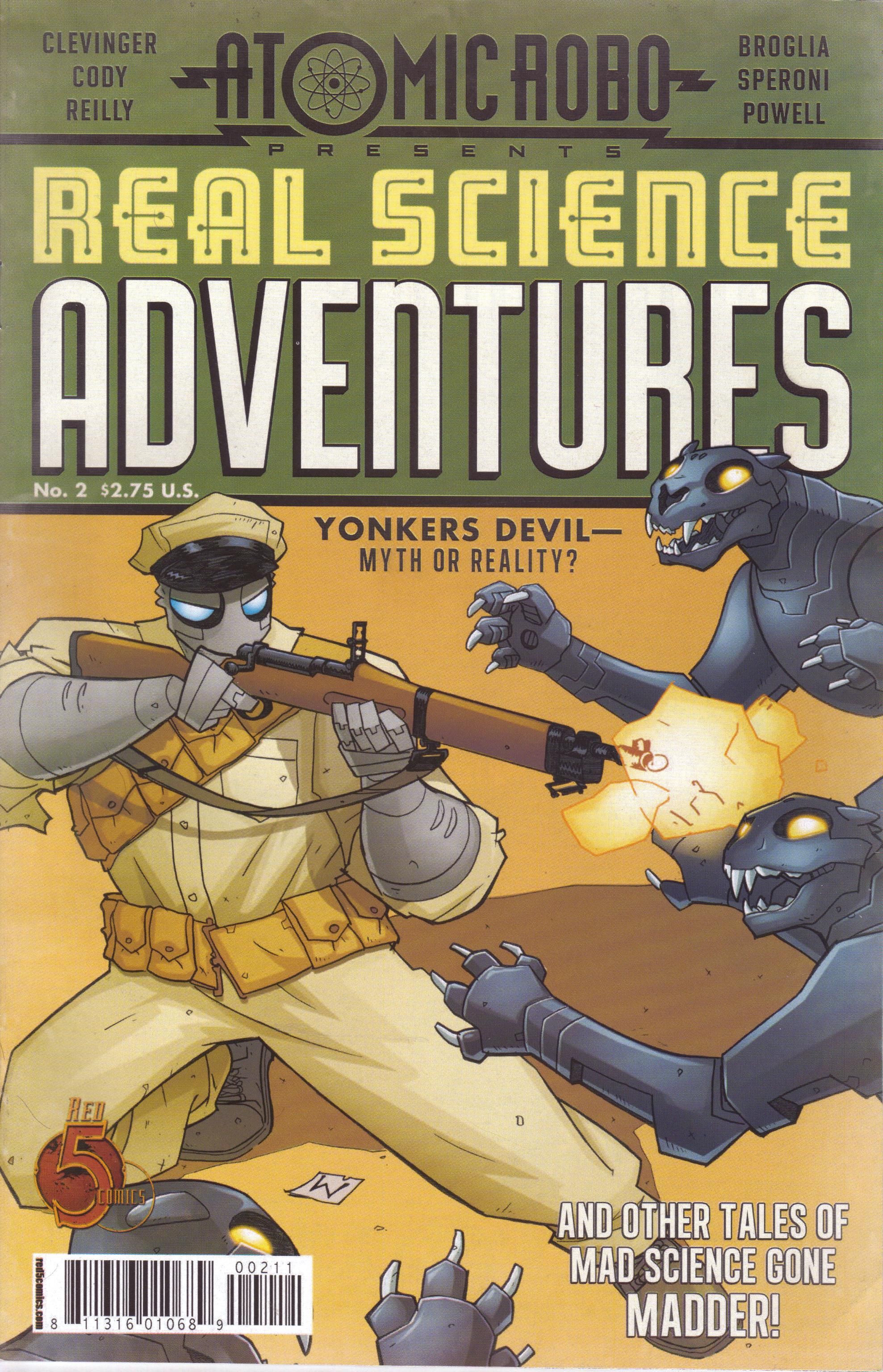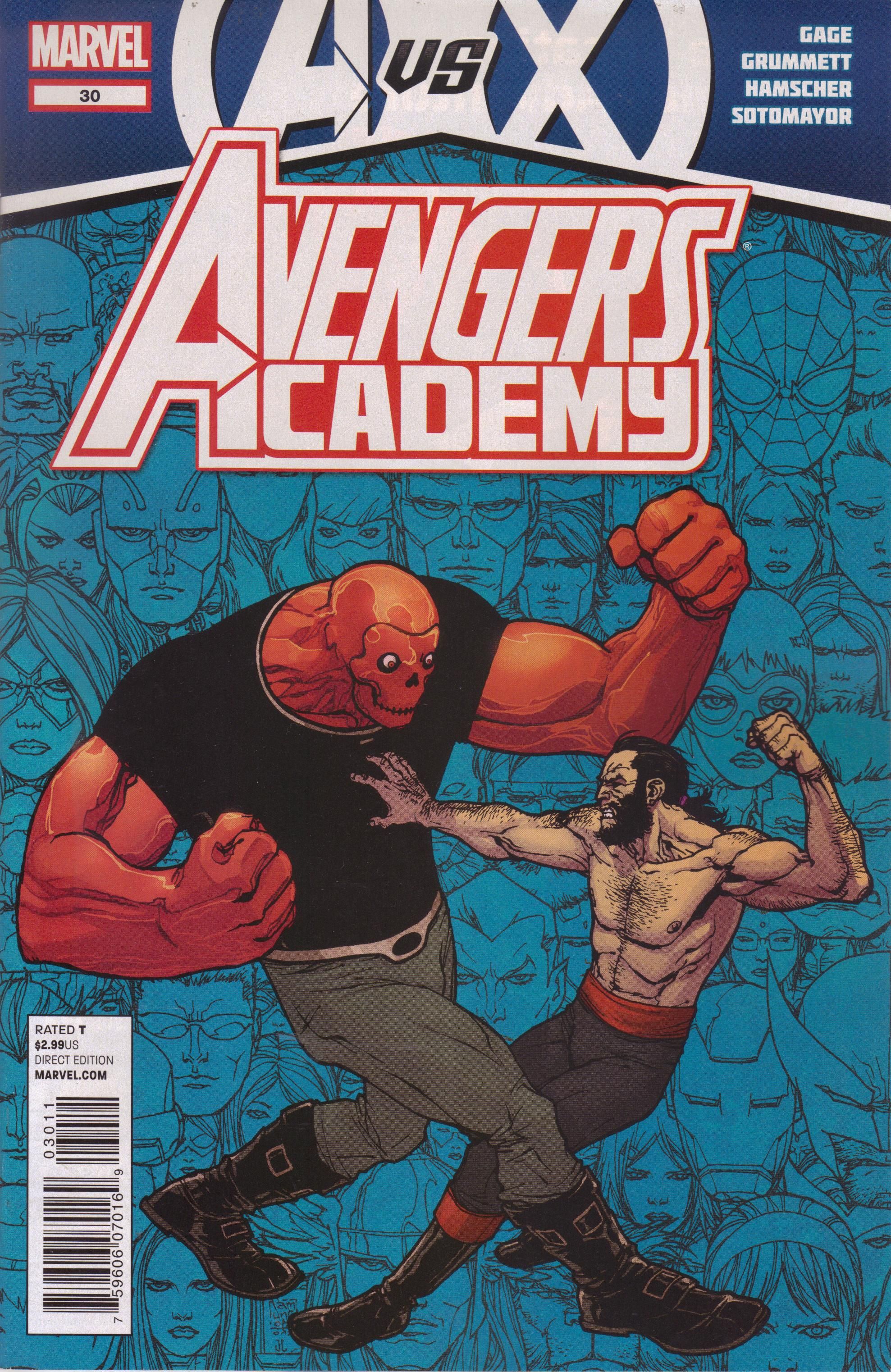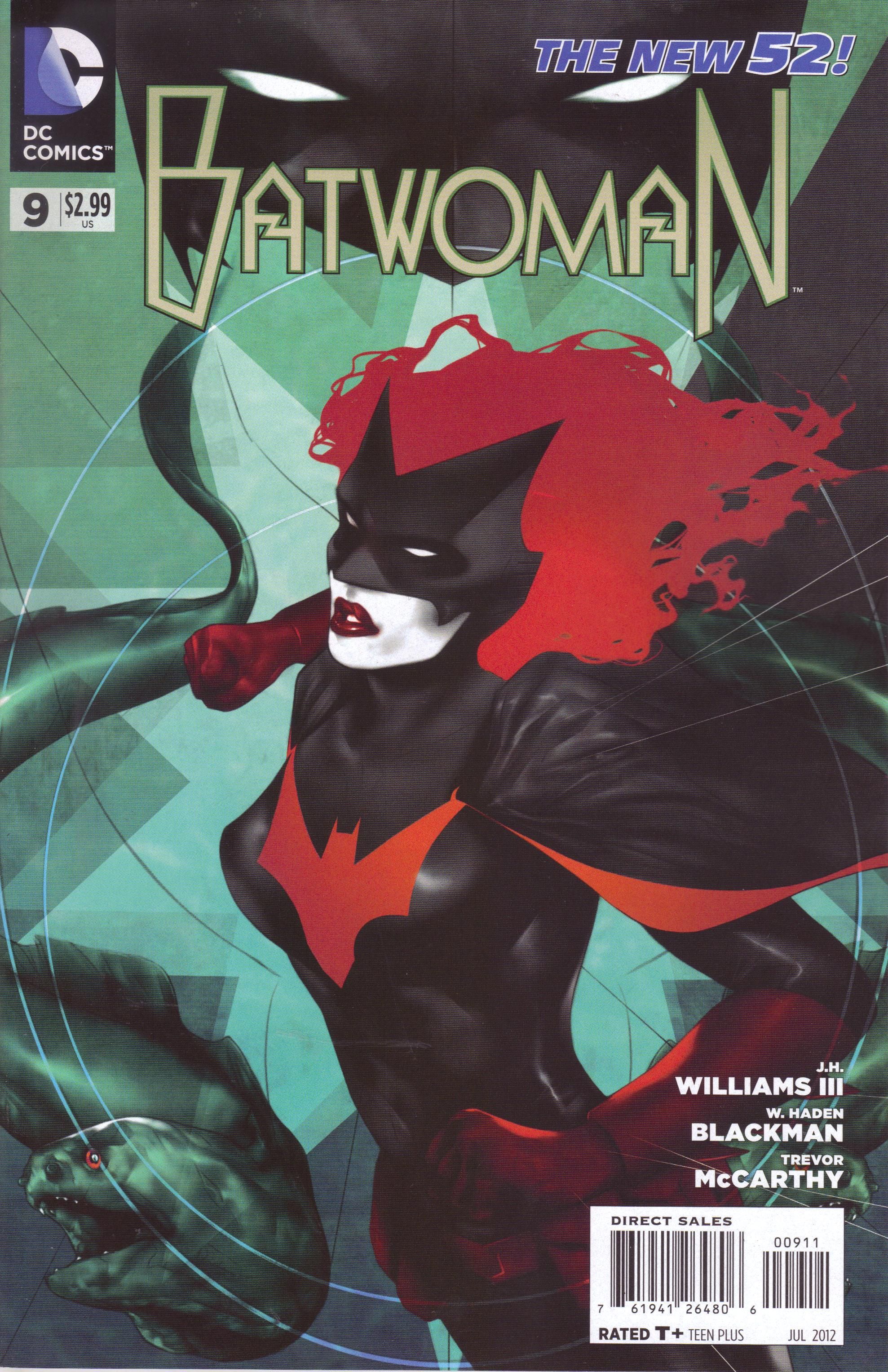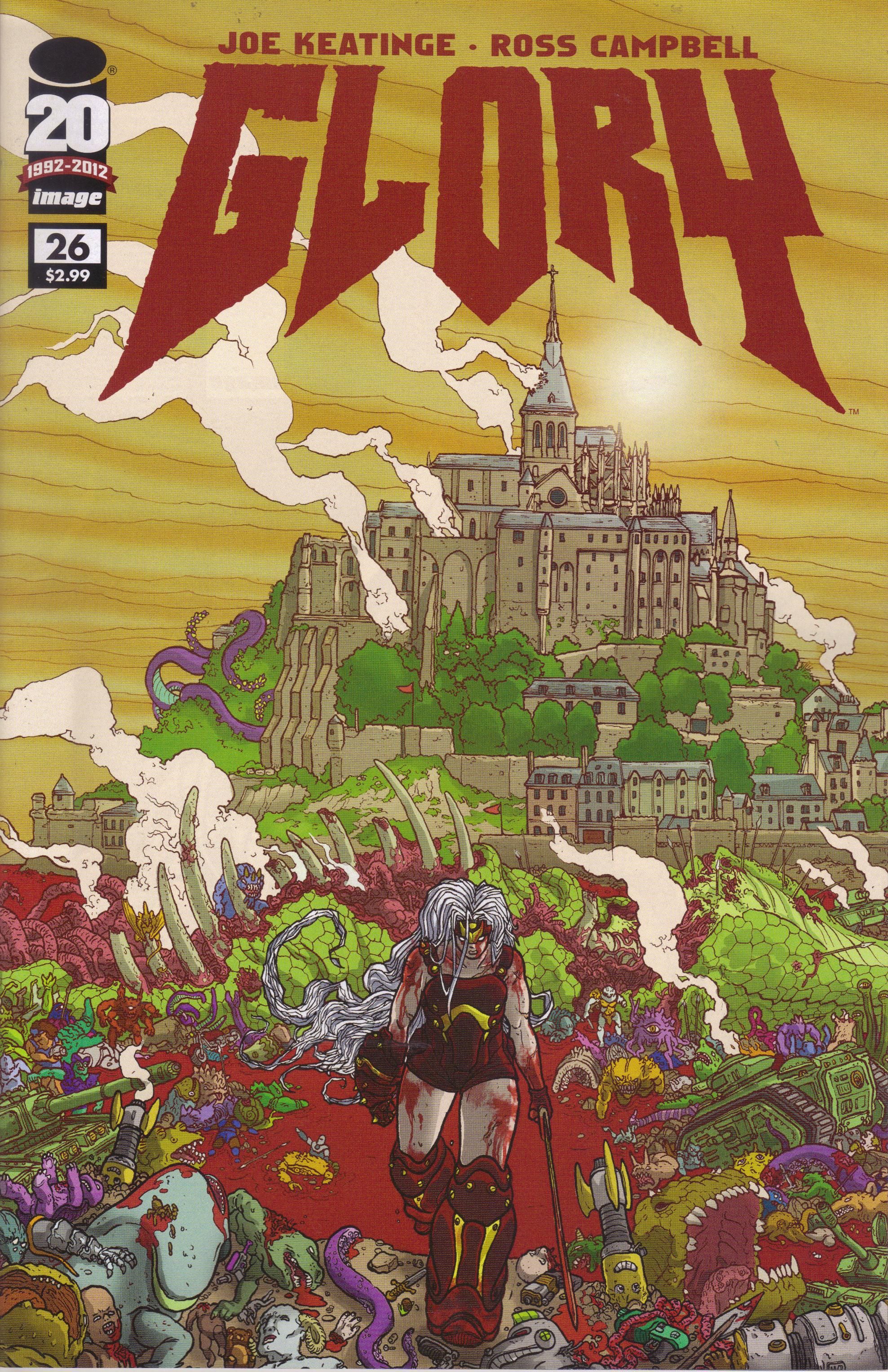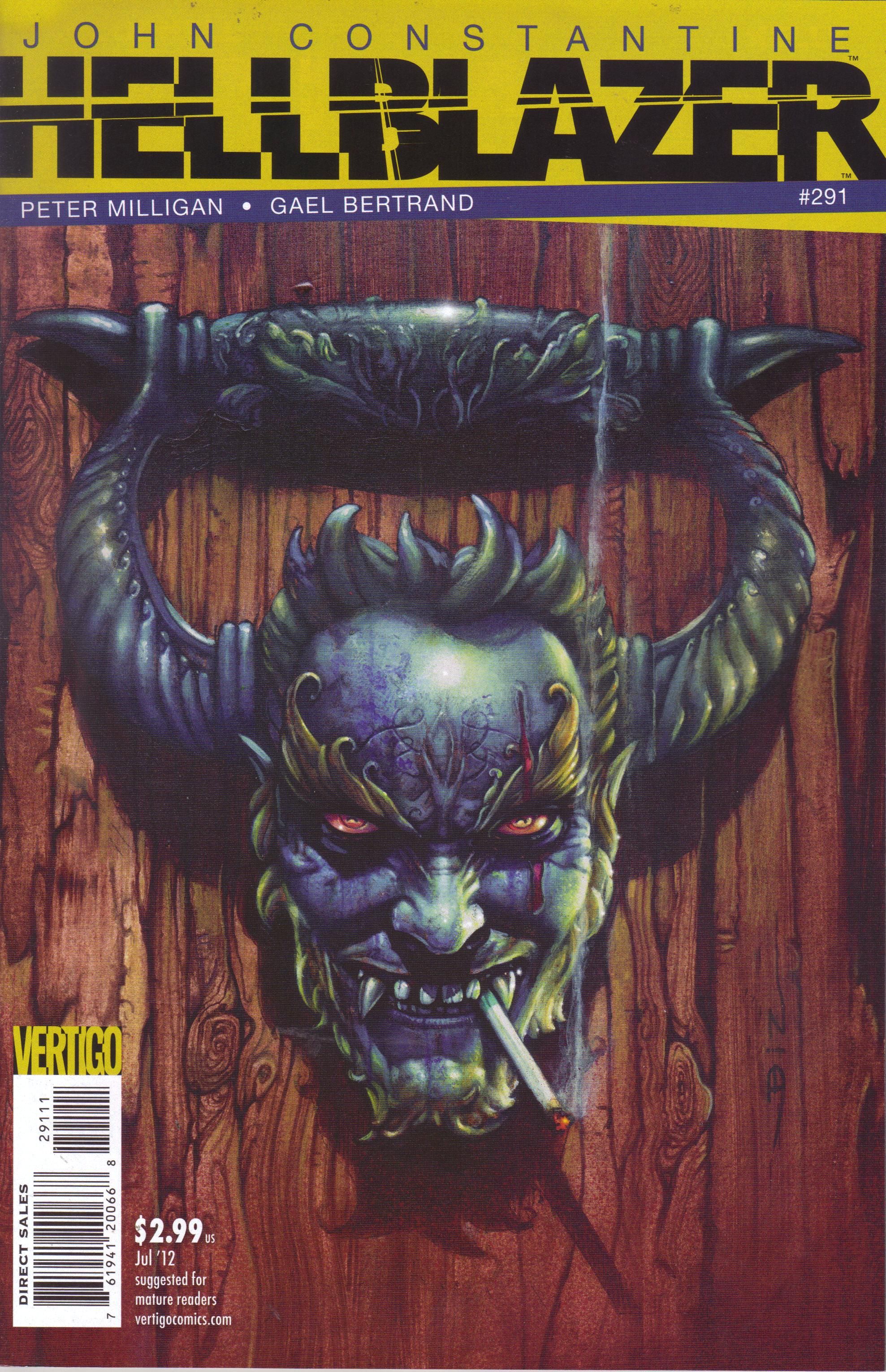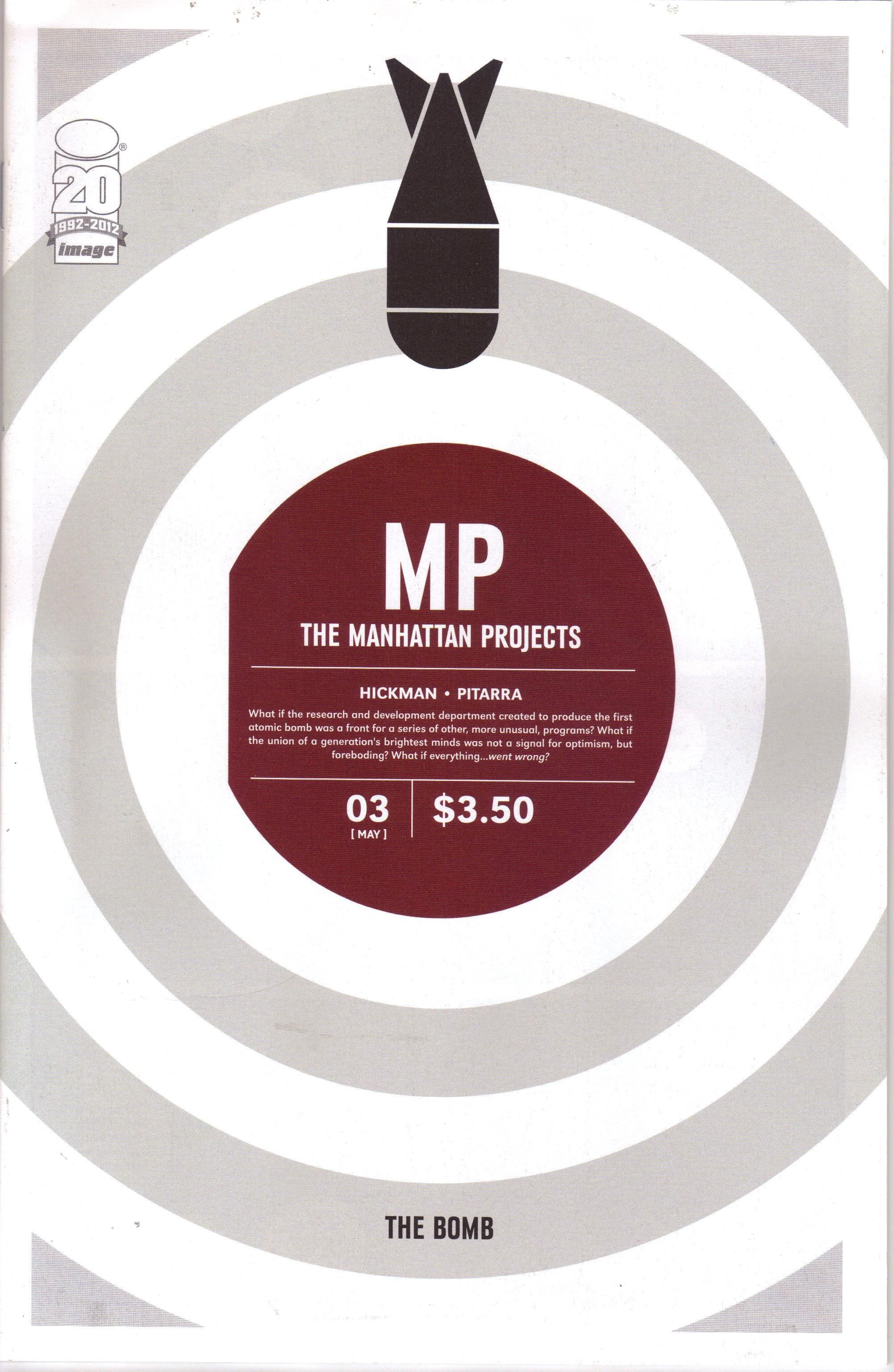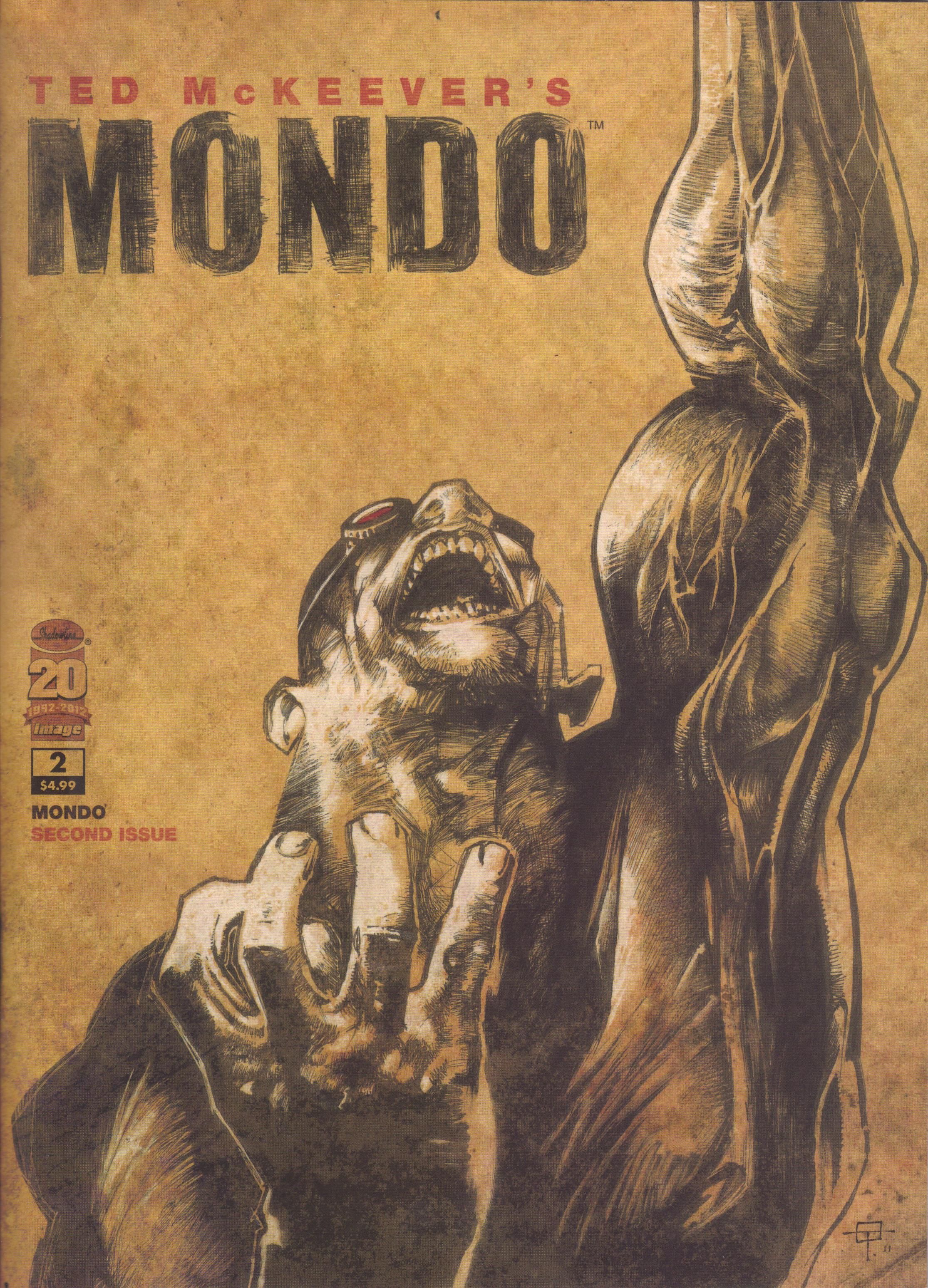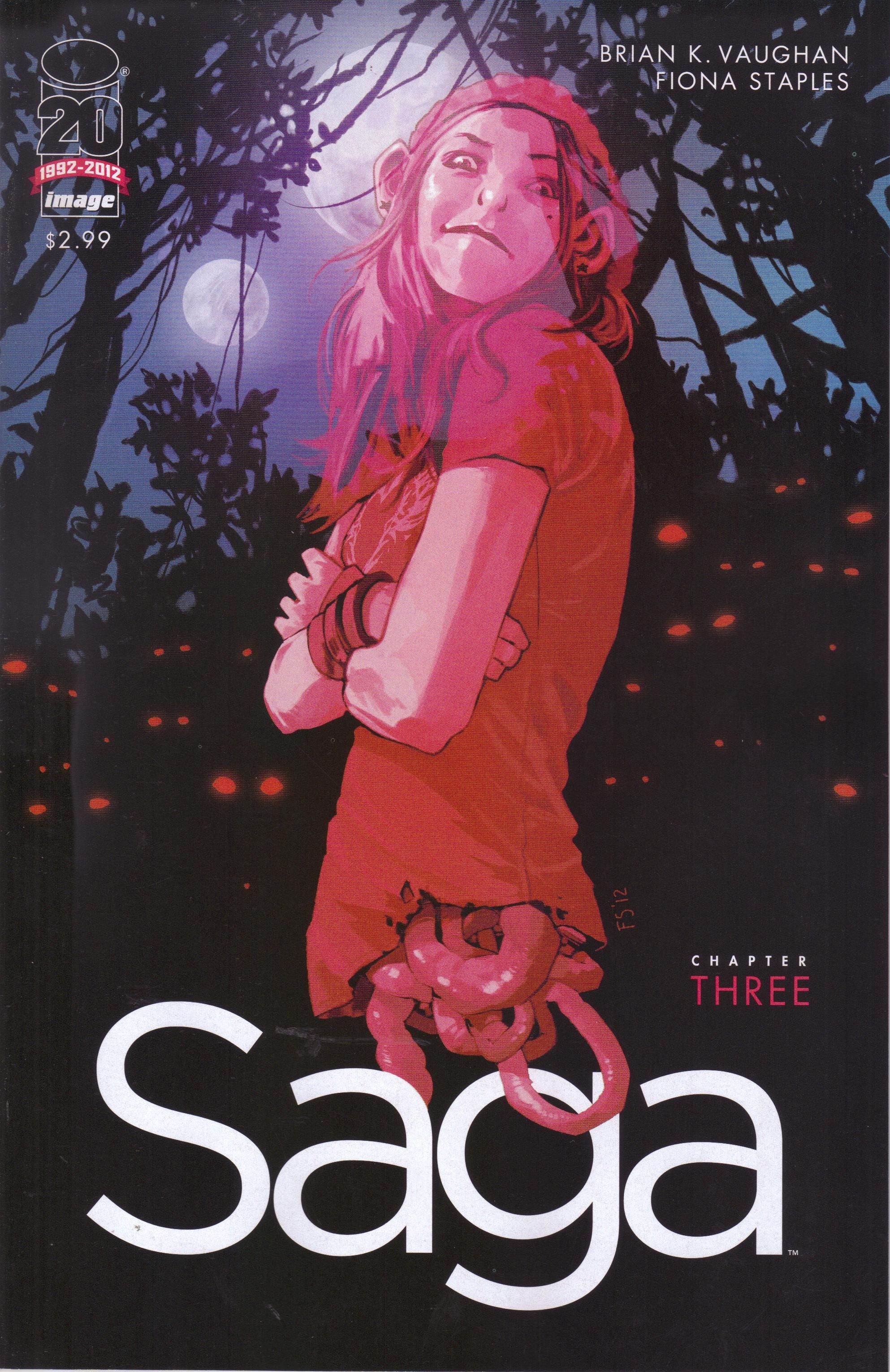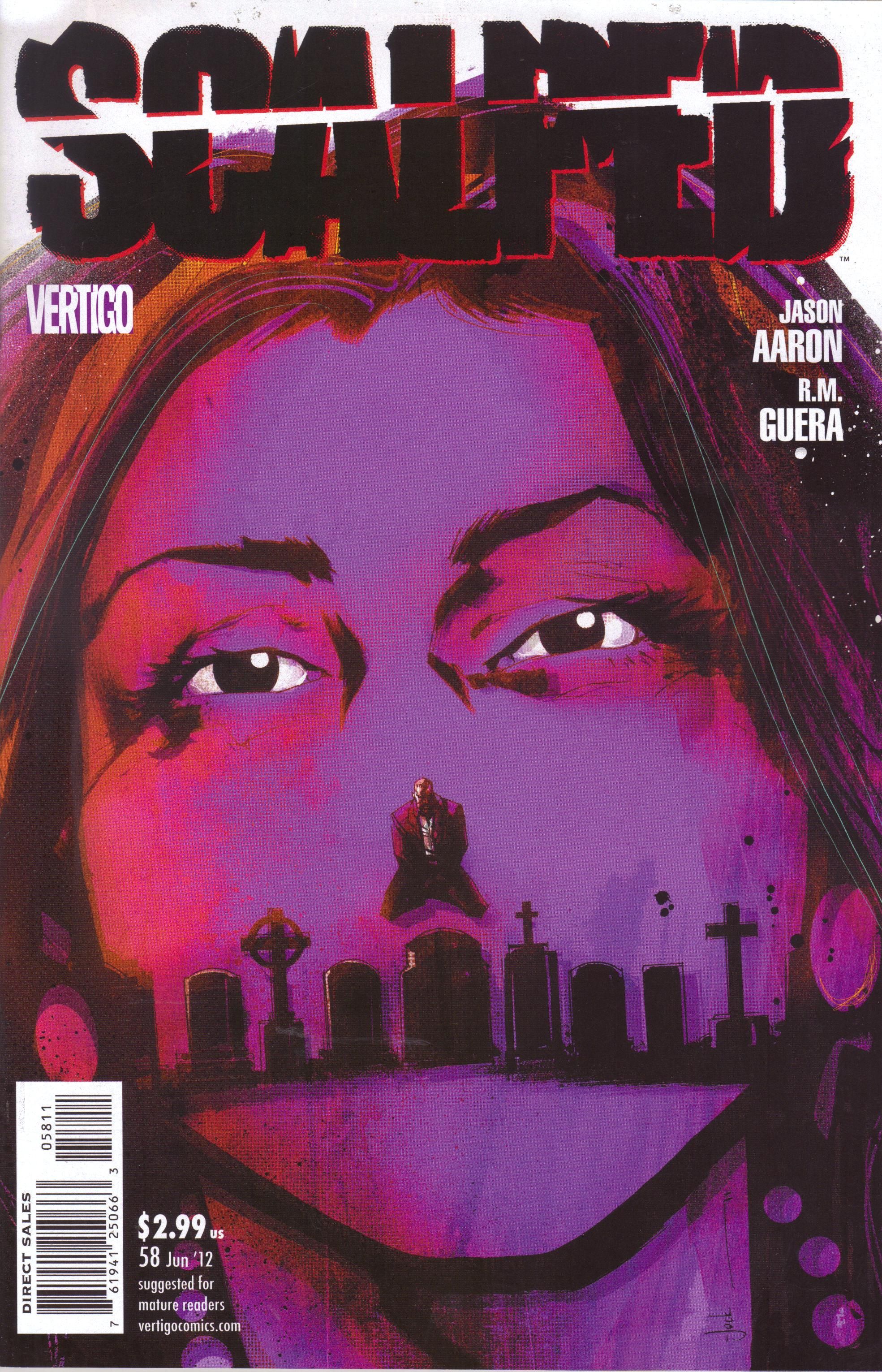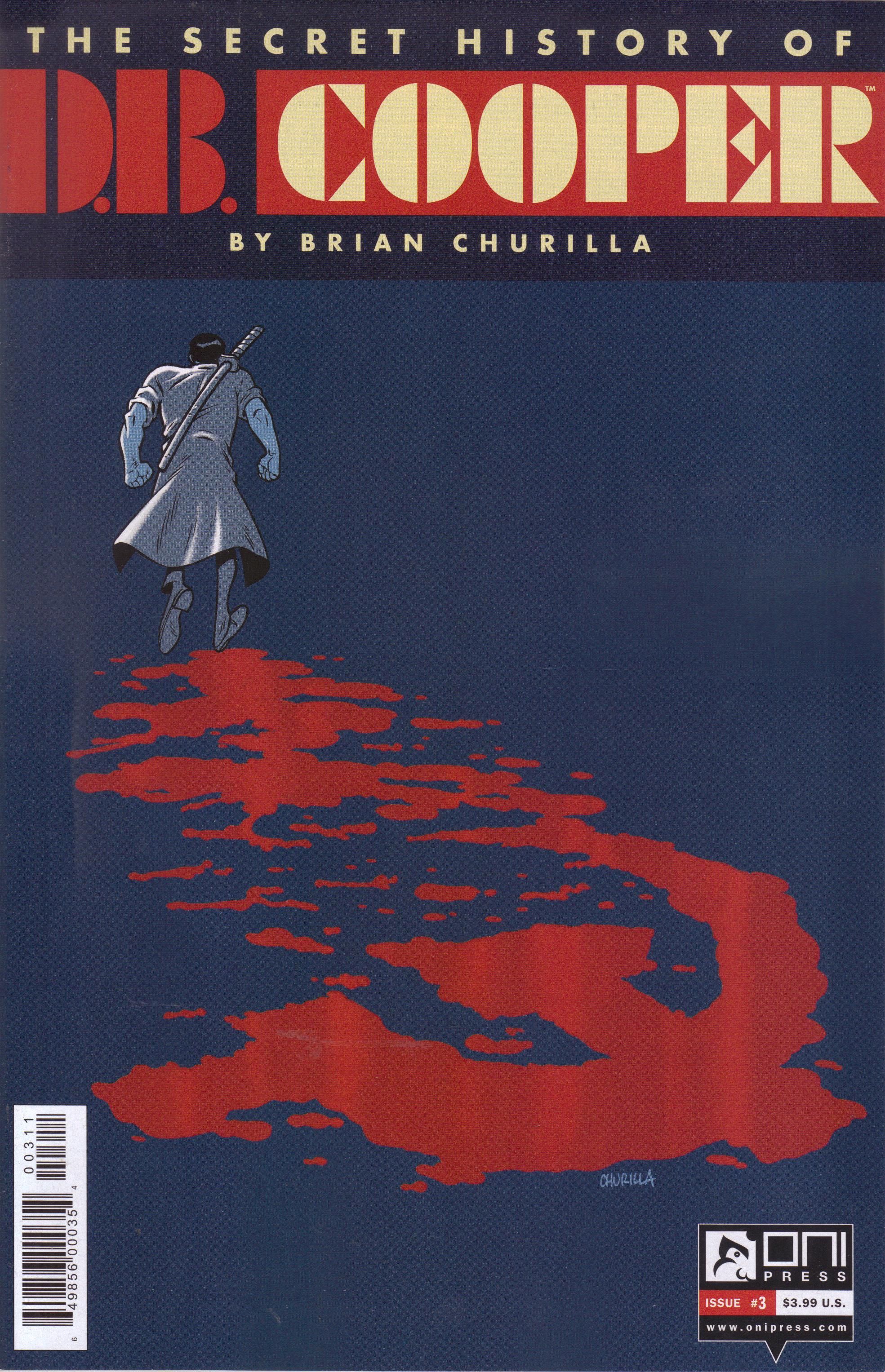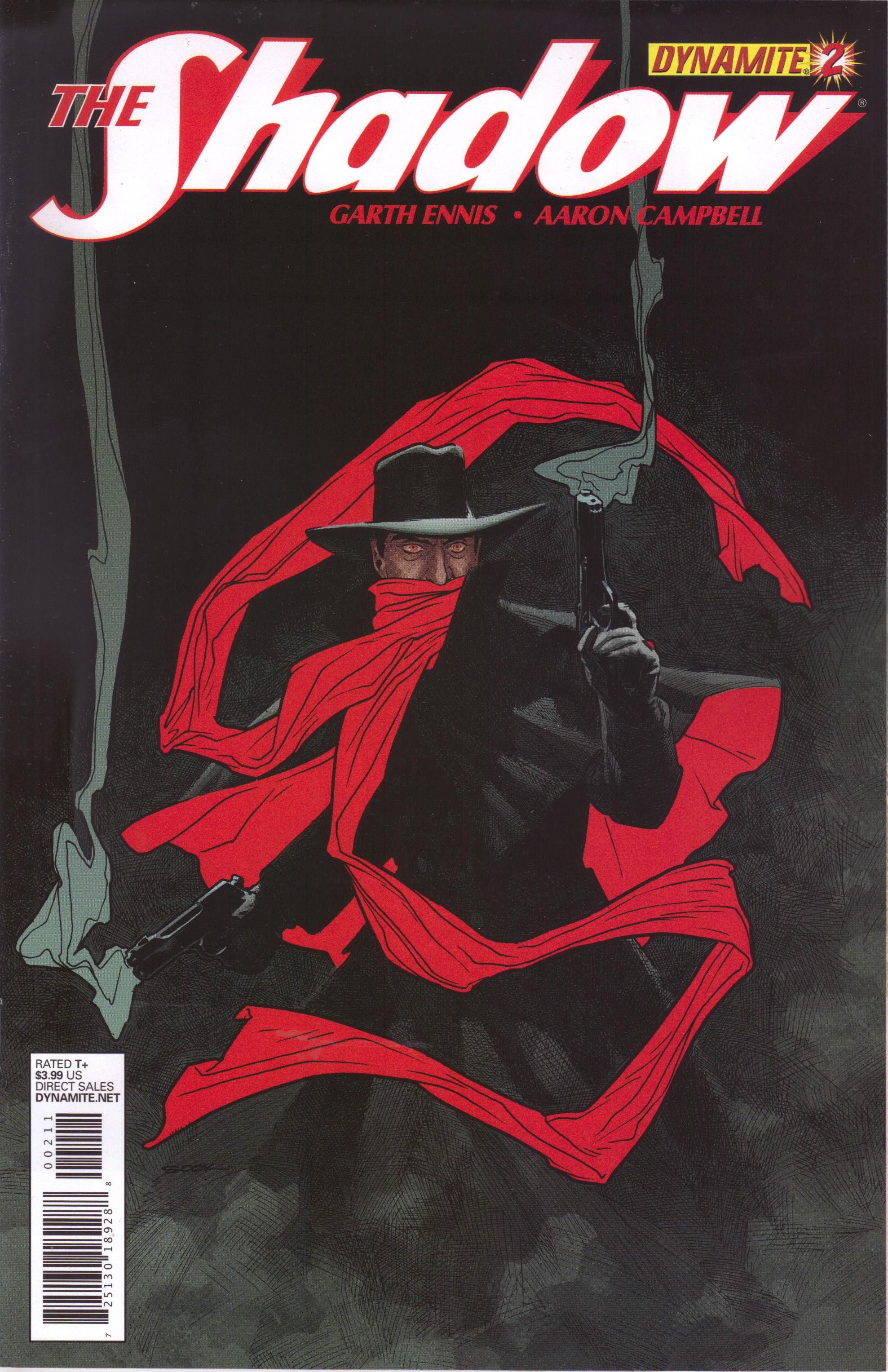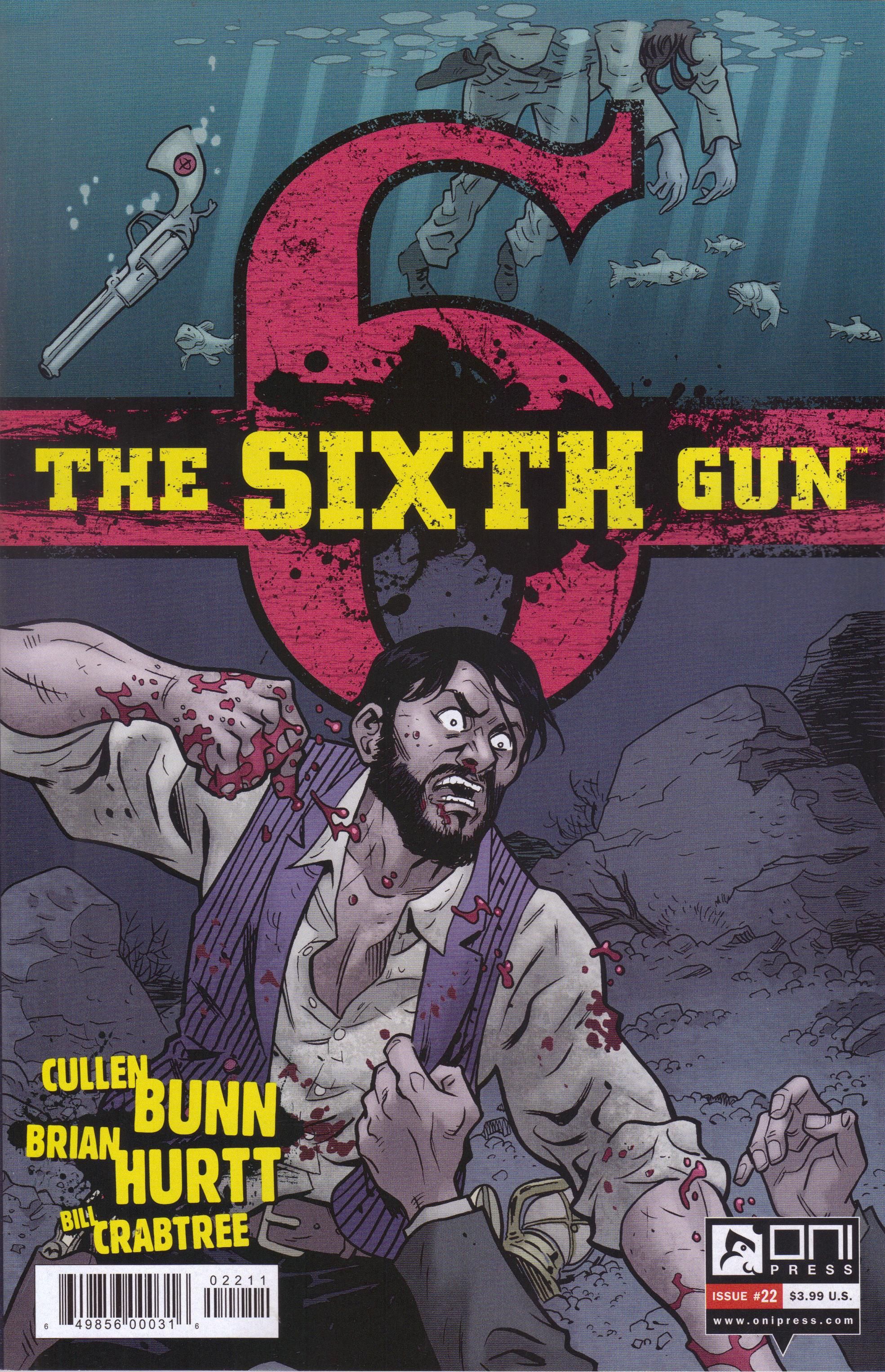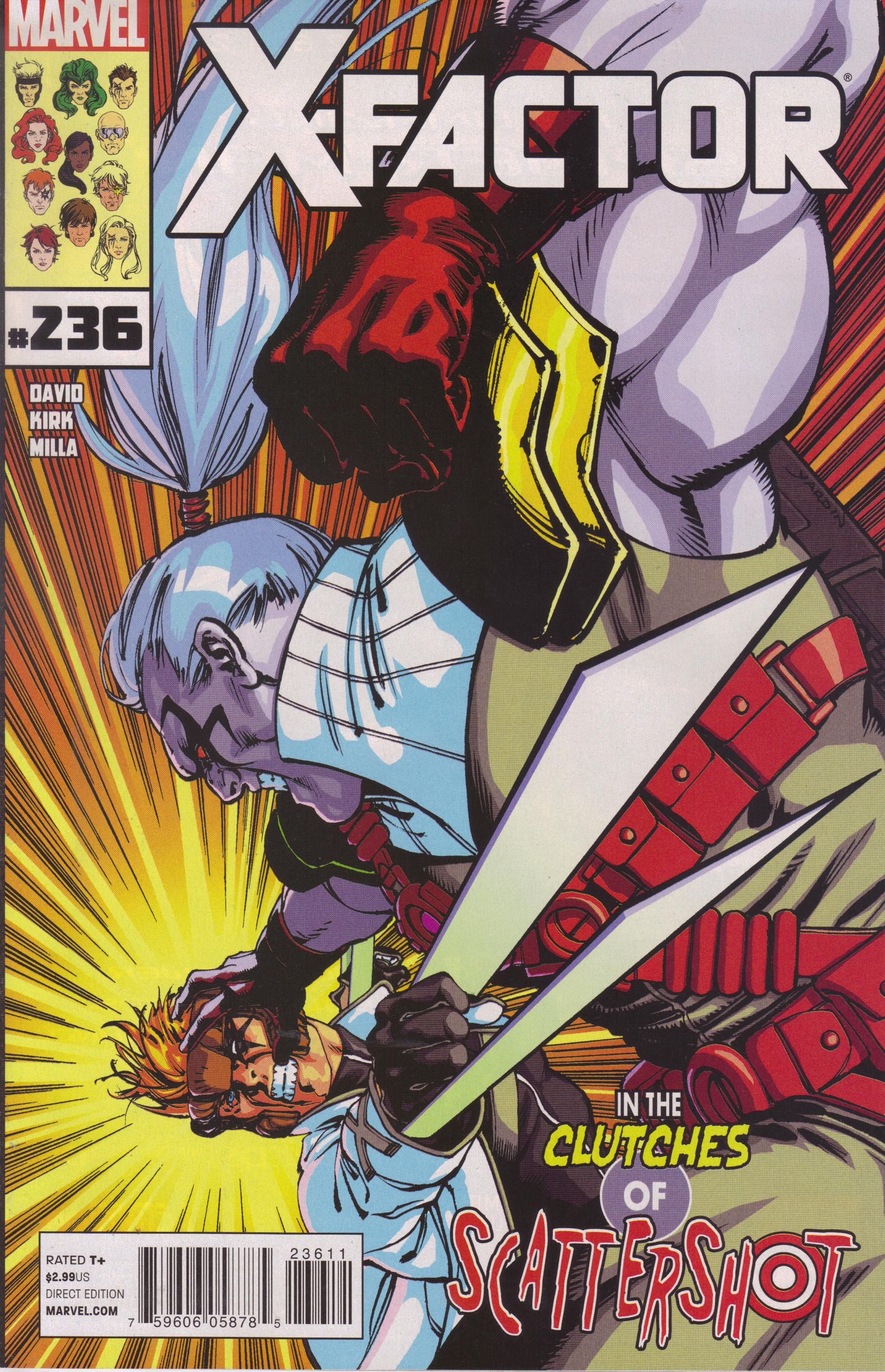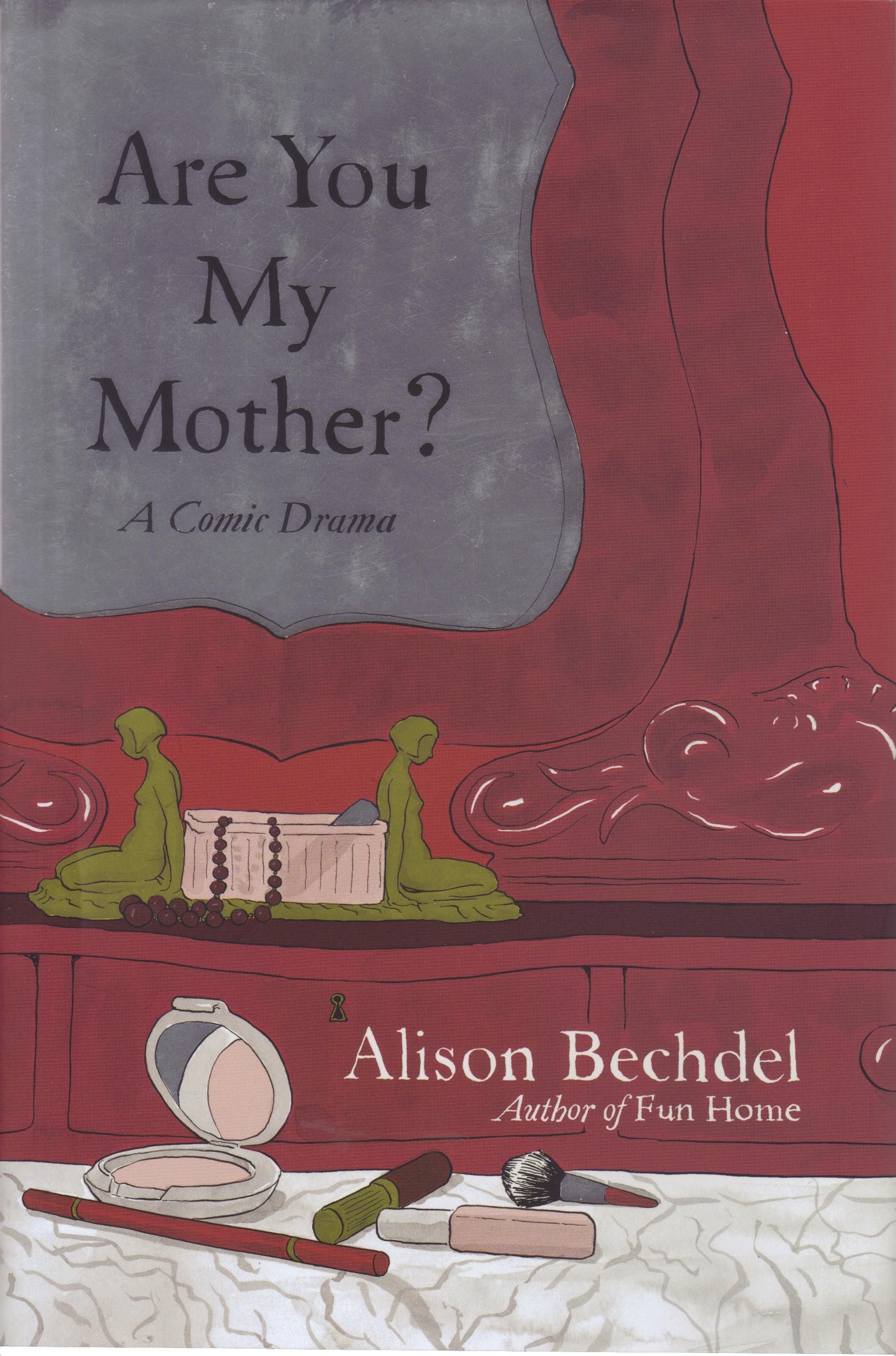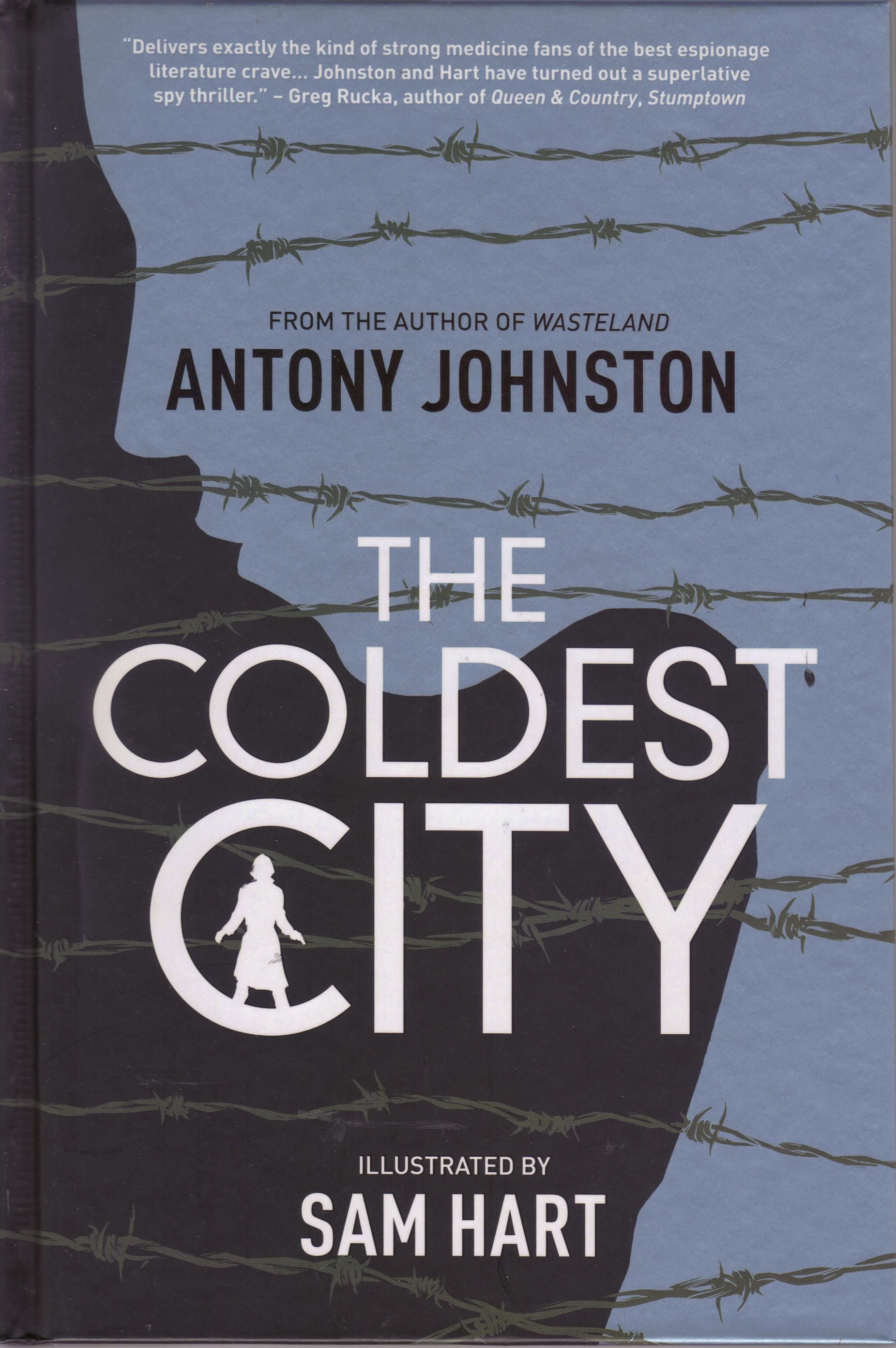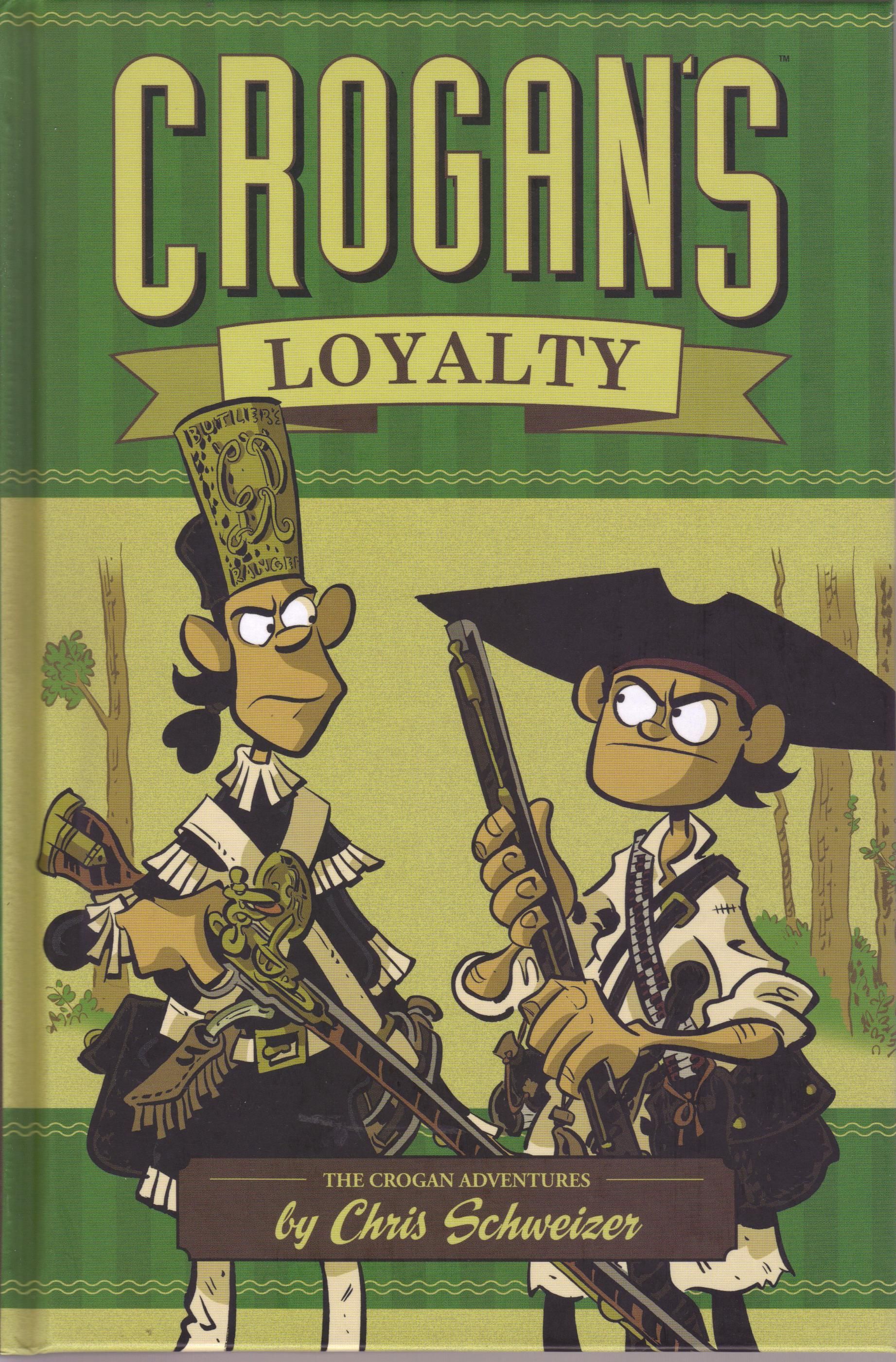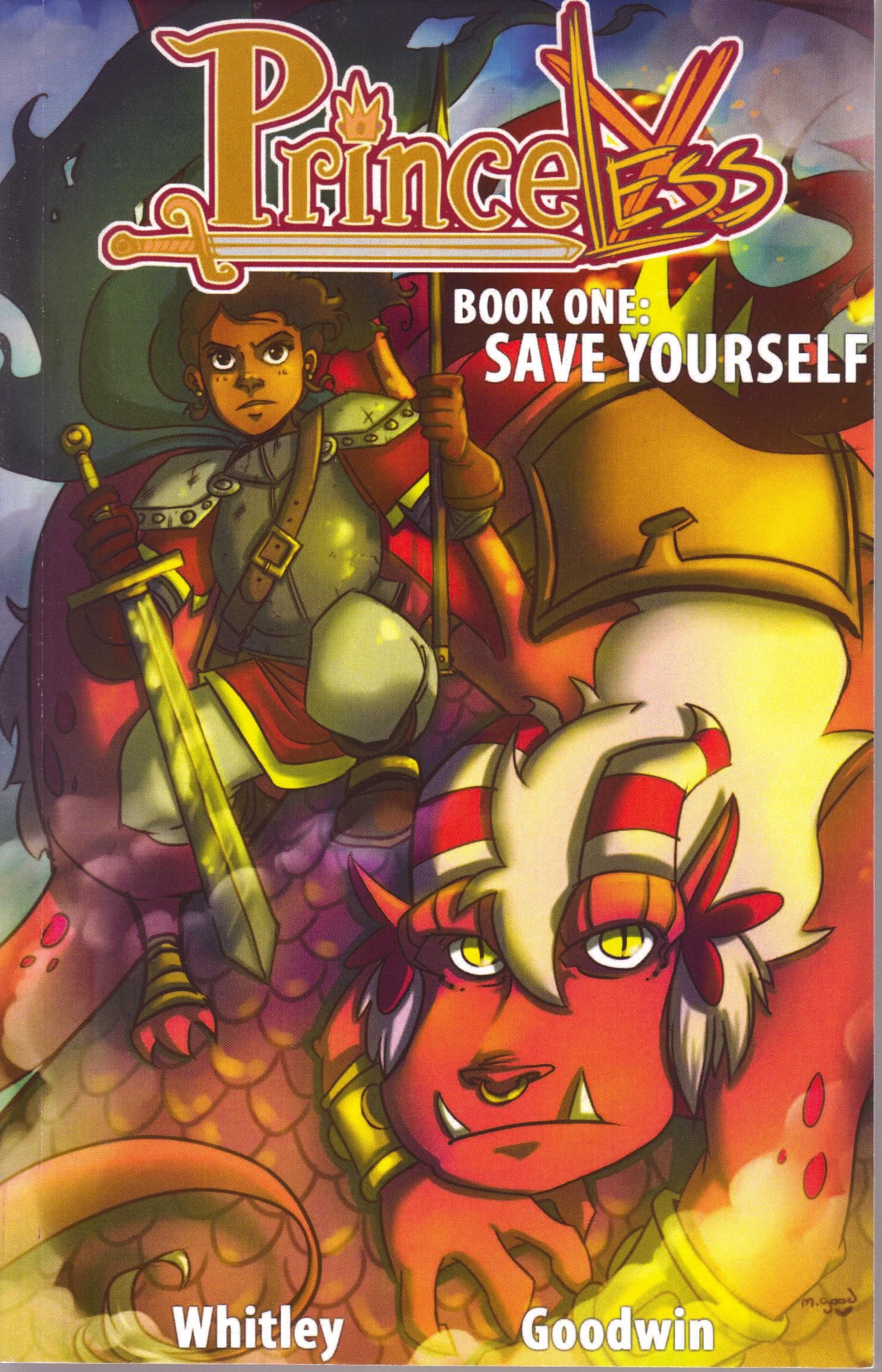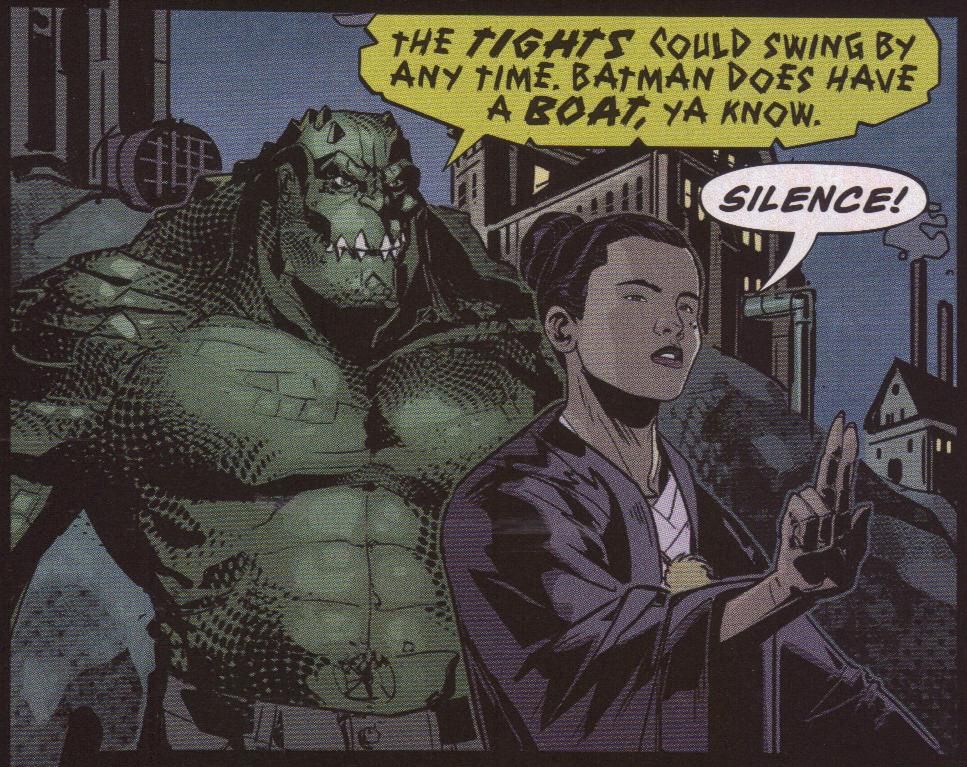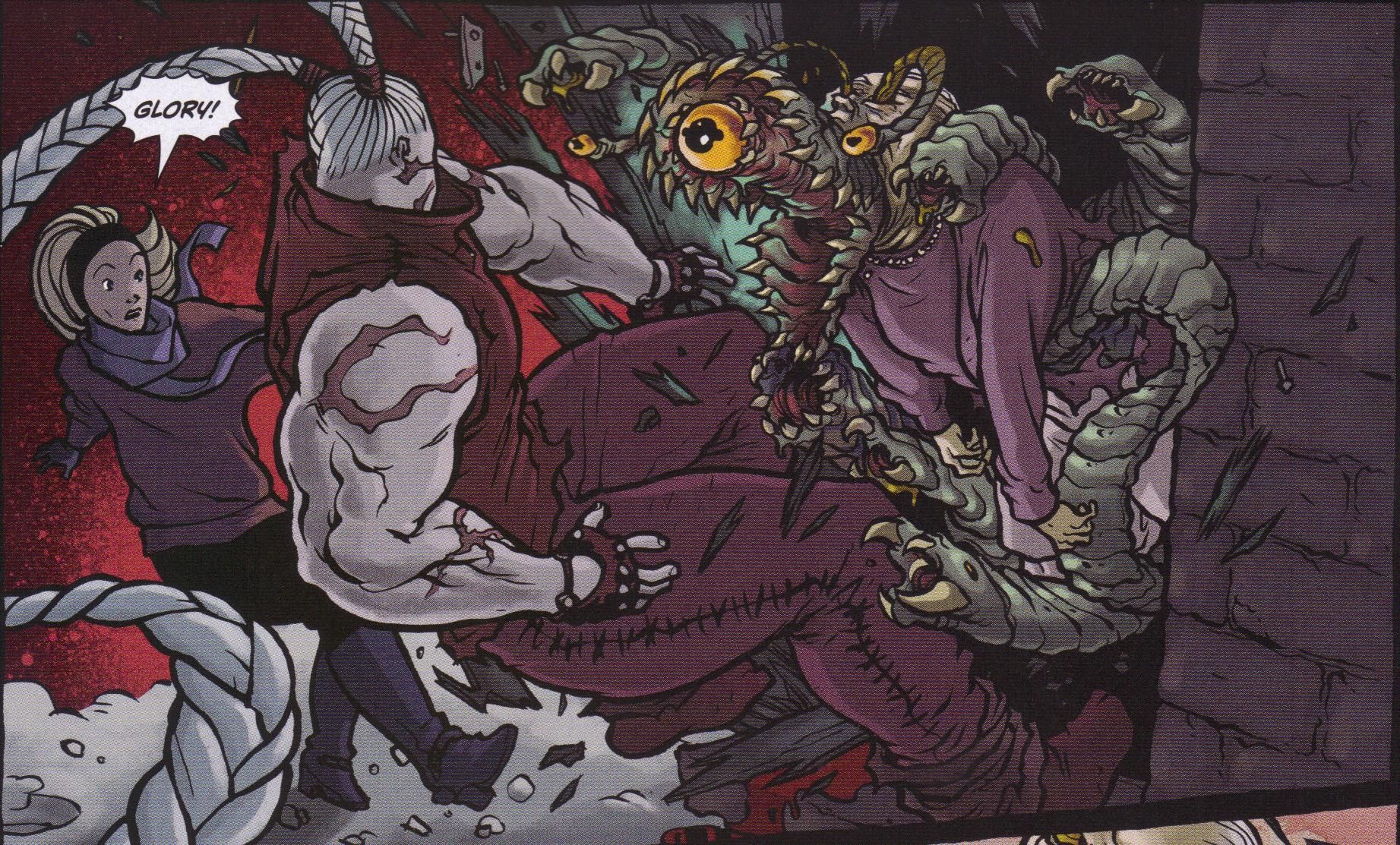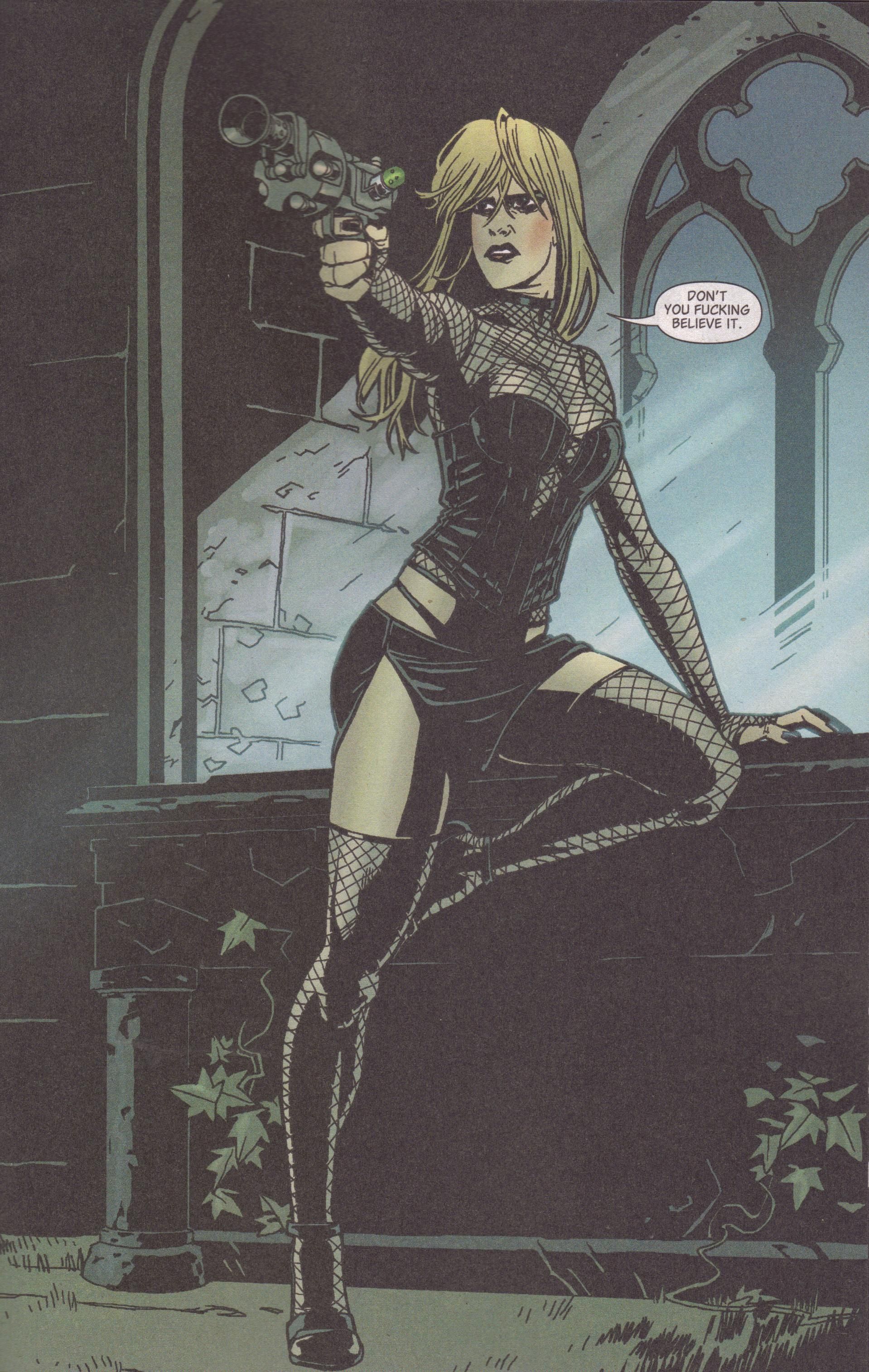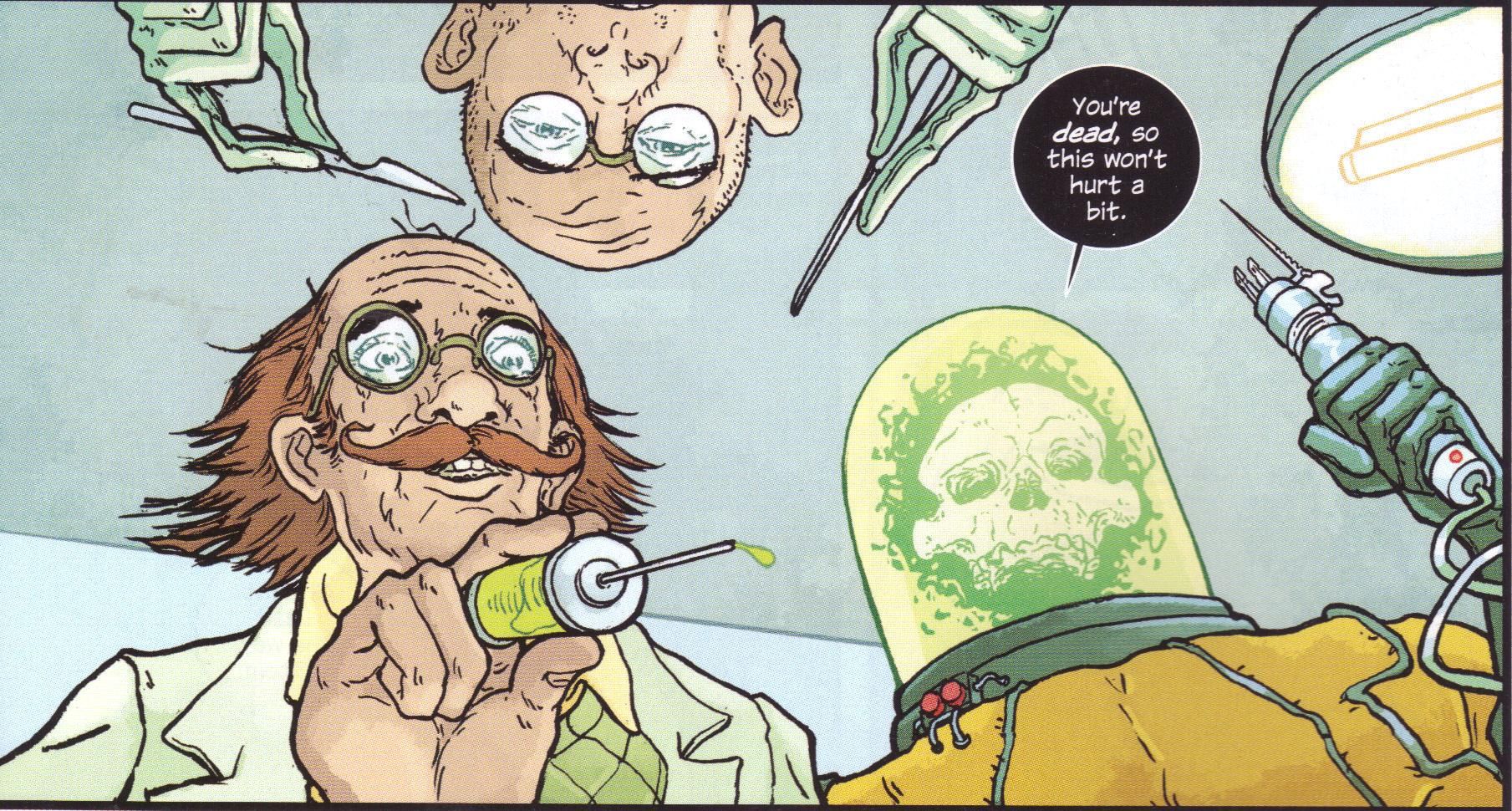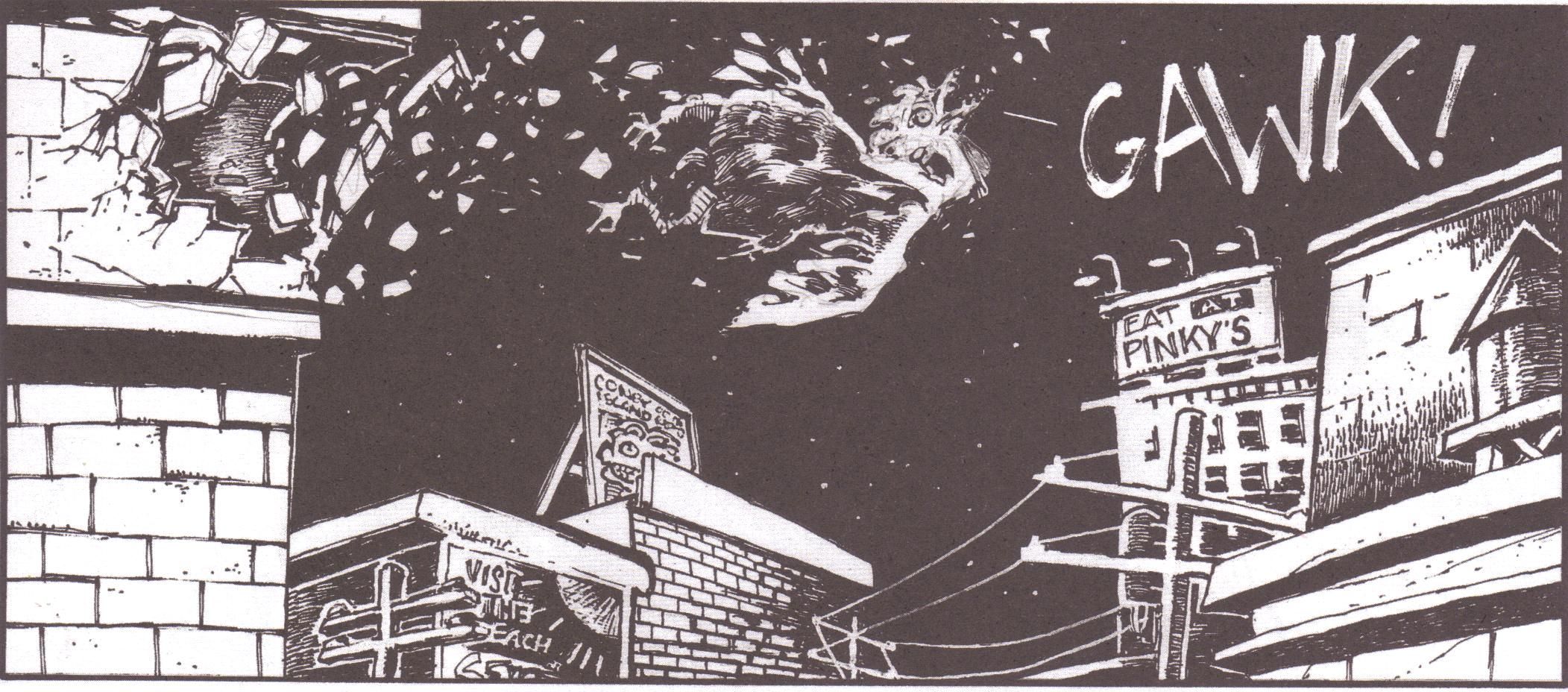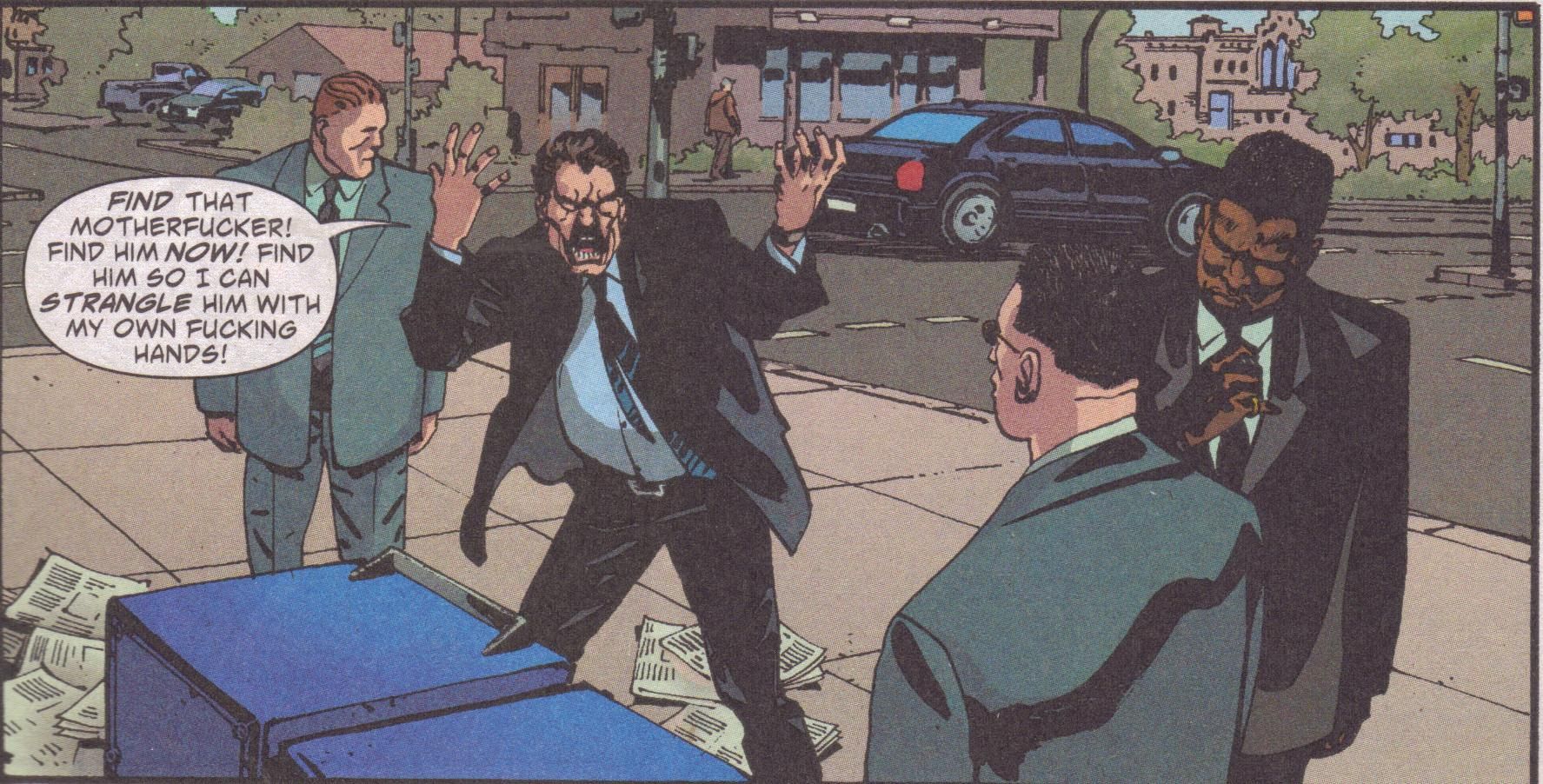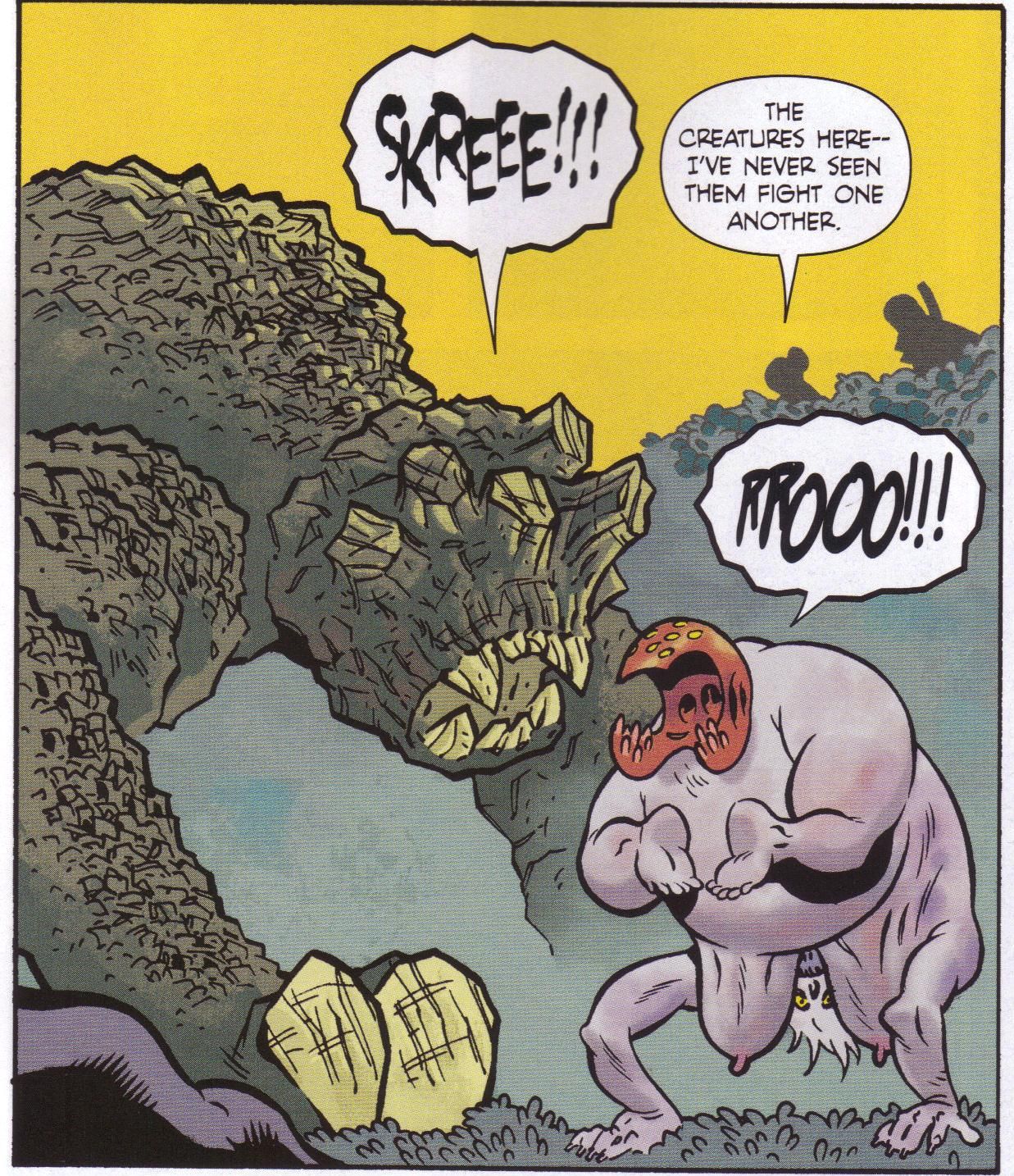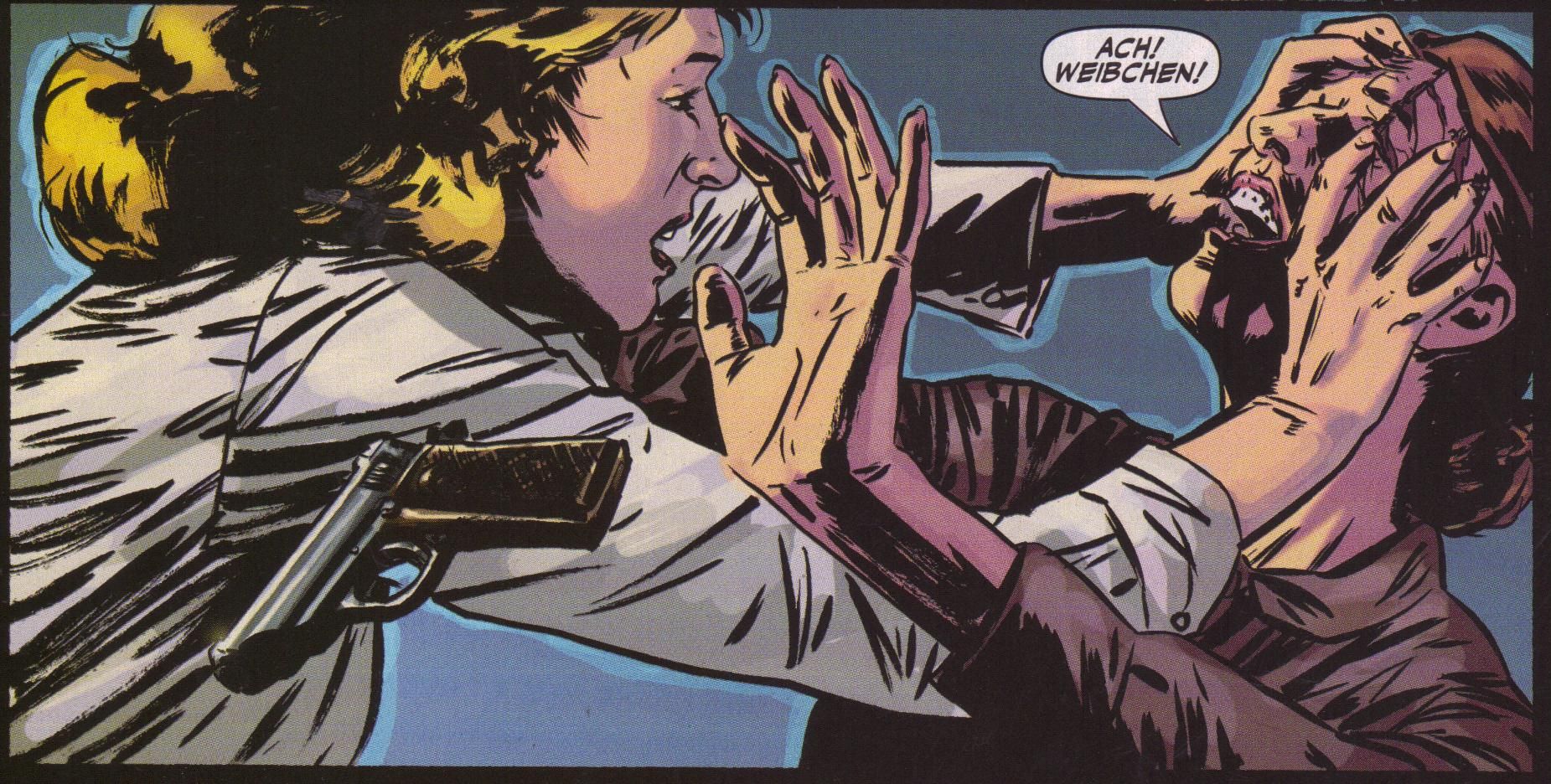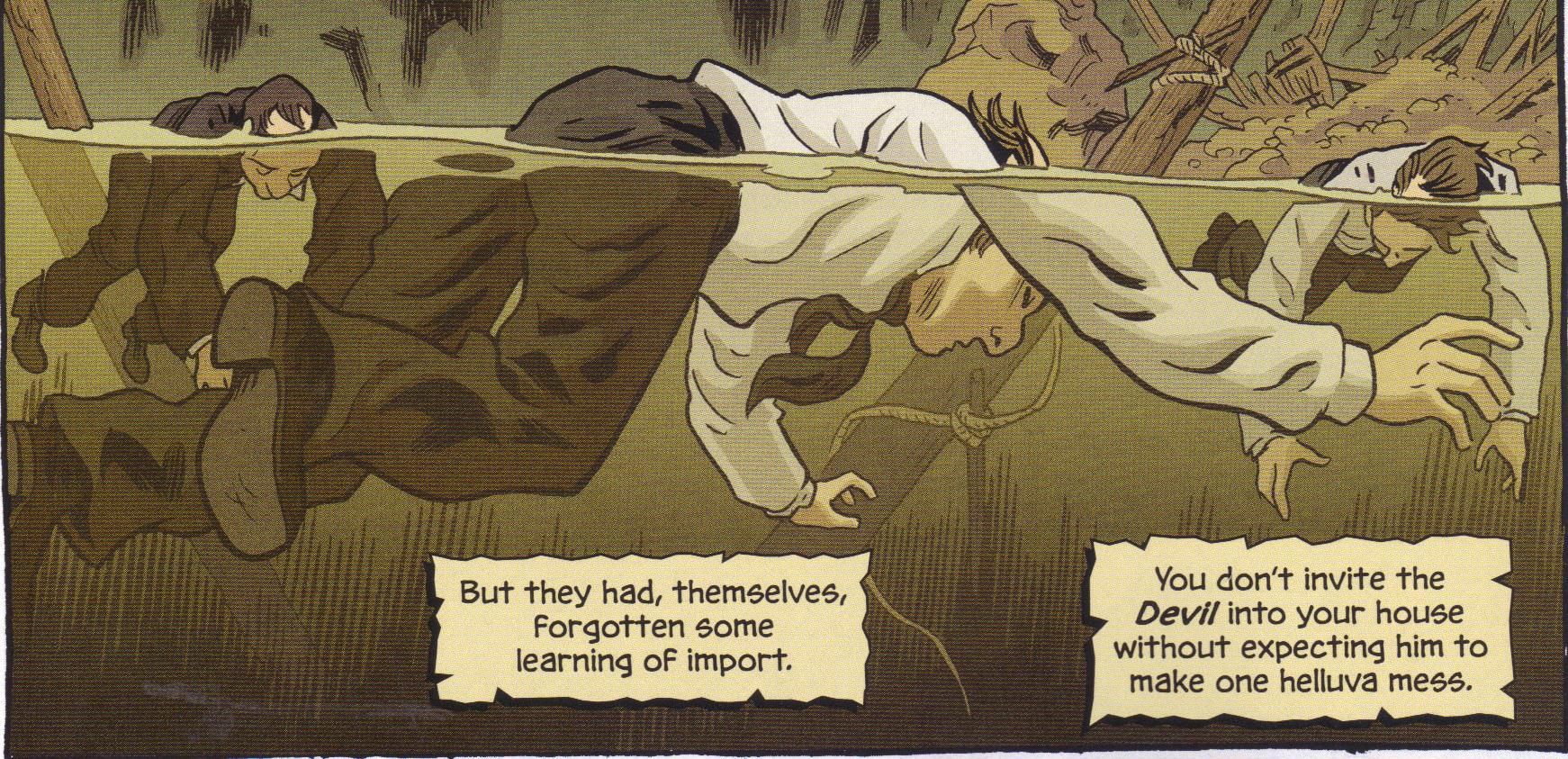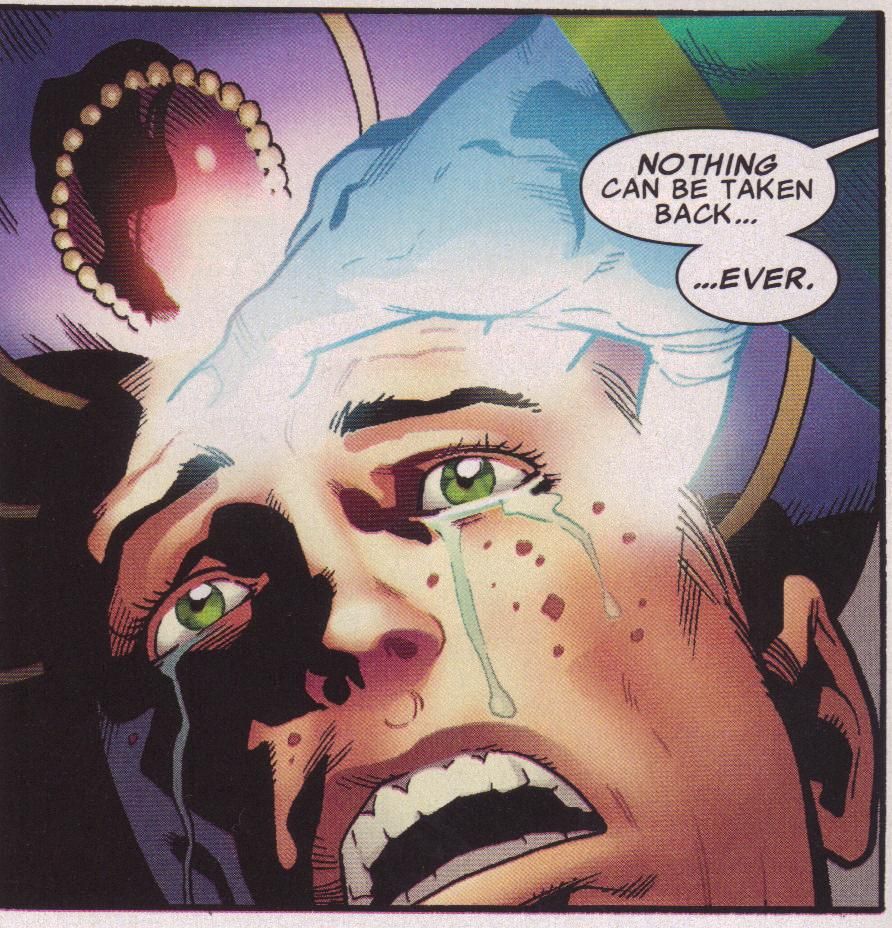It is demonstrably plain that, were the whole matter of victualling the world on a non-national footing taken right out of the hands of the strutting male and handed over to a dozen sensible women who do not want to have their children killed, politics, which are nothing but a glorified form of housekeeping, would long since have been deflated to the problem of running a canteen. (William Gerhardie, from God's Fifth Column)
Atomic Robo Presents Real Science Adventures #2 by Brian Clevinger (writer), Matt Speroni (colorist), Jeff Powell (letterer), Ryan Cody (artist, "To Kill a Sparrow Part 2"), Rob Reilly (artist, "Monster Hunters"), John Broglia (artist, "Leaping Metal Dragon Part 2"), and Zack Finfrock (artist/colorist, "Atomic Robo Vs. Rasputin"). $2.75, 21 pgs, FC, Red 5 Comics.
The biggest problem I have with the first two issues of the new anthology series starring Mr. Robo is that there are too many stories in them. Both have featured reprints from earlier issues, and that's fine, but the two serials running in the issues are each four pages long, and it's really hard to get any momentum going with only four pages of story. Both "To Kill a Sparrow" and "Leaping Metal Dragon" feel slight so far, and that's too bad, because the Sparrow is a cool character and Robo hanging out with Bruce Lee ought to be awesome. "Monster Hunters" features the bad guys from Majestic, which means Clevinger is fitting it into the bigger plot, but it's a bit confusing. If you've read the story (Bill Reed, I'm looking at you), is Robo in the story at all? If so, why does Majestic care about fooling the Monster Hunters? If not, what the heck? It's kind of strange.
I like that Clevinger is telling us these nifty short stories that don't fit into the main mini-series, but I do wish that he'd use his space a bit more wisely. If the Sparrow and Bruce Lee stories are only going to be 24 pages long (6 chapters of 4 pages each), couldn't we get 8 pages an issue and finish them up in 3 issues instead of 6? This issue is 21 pages long, but couldn't it be 24 pages with three 8-page stories and no reprint? I don't know - I'm just spitballing. But this is a frustrating issue, and it doesn't really have anything to do with the quality of the stories, just the length.
Rating: ★ ★ ★ ★ ★ ½ ☆ ☆ ☆ ☆
One totally Airwolf panel:
Avengers Academy #30 ("Protective Services Part 2") by Christos Gage (writer), Tom Grummett (penciler), Cory Hamscher (inker), Chris Sotomayor (colorist), and Joe Caramagna (letterer). $2.99, 20 pgs, FC, Marvel.
Noted Bendis Hater Steven R. Stahl mentioned in regard to last issue that the way Sebastian Shaw got enough energy to escape from Madison Jeffries was way stupid, and I had some fun with him, because it's comics, after all. Here's the thing about Stahl, though: he's right, but should we care? What I find very interesting about comics is that writers are often writing about difficult subjects, and should we forgive them for not knowing everything about physics or thermodynamics or chemistry? And why does this only apply to the sciences? I've noticed over the years that a comic book writer can get savaged for not knowing physics, yet when I complained about Paul Cornell's lackadaisical attitude toward history in Demon Knights #1, a bunch of people told me that it's just comics and why should I worry about it? How much should we expect comic book writers to know, after all? I've often wondered about this when it comes to writers writing people like Reed Richards and Tony Stark, who are supposed to be geniuses. Are any comic book writers geniuses in physics? No, they're not - not even Warren Ellis or Grant Morrison, because if they were, they'd be motherfucking physicists. So I admit that Stahl is right, even though I'm willing to give Gage a pass, because the way Shaw escaped was clever enough. Sure, if you think about it, it falls apart, but guess what? If you think about a lot of superhero comics too much, they fall apart.
This ties into something that has been bugging me for a few issues now, and that's the Iron Giant on the Academy's grounds. In the Airwolf panel below, Dust says that the Sentinel is "built to kill mutants." Again, I point out that it's a robot. Surge even says it has a metal brain. Hasn't it been reprogrammed yet? Is it that hard to reprogram a Sentinel? I don't know, but I wish Gage would address it, because it seems like it's such a crucial part of the story these days, as everyone keeps freaking out when they see the Sentinel. I'm just curious. I know some other writer has probably addressed this already in that mini-series where Juston hangs out with the robot, but nobody read that, did they?
This was an okay issue, although the fight between Hercules and Shaw points out how unbelievably stupid superhero fights often are. Hercules has the advantage of being invisible, but he speaks so Shaw can find him (when Phineas and Ferb makes fun of that specific problem in an episode in which Dr. Doofenschmirtz is invisible yet keeps talking so Perry can find him, it's probably past the point where you can use it in a serious setting). When he starts to show him the Shield of Perseus (the one with Medusa's face on it), he tells Shaw what he's doing, allowing Shaw to close his eyes. Then he cuts him with a sword that can cut anything ... except someone who can absorb energy. Shaw has been around for a long time - hasn't anyone figured out yet that you could stab him with a plastic spork and that would be more effective than all this fancy crap? This is another reason why thought balloons are awesome - Gage is trying to let the reader know what weapons Herc has, but because thought balloons are déclassé, he has to have Herc speak, so Shaw hears him. It's just d-u-m.
So. I enjoy ranting, don't I? It's not a great issue of AA, but it's okay. It'll get better, right?
Rating: ★ ★ ★ ★ ★ ½ ☆ ☆ ☆ ☆
One totally Airwolf panel:
Batwoman #9 ("To Drown the World Part Four") by J. H. Williams III (writer), W. Haden Blackman (writer), Trevor McCarthy (artist), Guy Major (colorist), and Todd Klein (letterer). $2.99, 20 pgs, FC, DC.
On 11 January, Batwoman #5 came out. This was the cover. On 16 May, Batwoman #9 came out, and we got this Ben Oliver abomination as the cover. I mean, I know that Williams drew that first one, and Williams is very good, and that cover might not be passed for best cover of the year, but really, Ben Oliver? What the fucking fuck? I mean, the image of Batwoman herself is terrible, and then we have ... a moray eel? Really? What the hell is a moray eel doing there? Nothing in this story suggest eels, nor does a majority of this story take place underwater (it does take place near water, so there's that). I just don't get how anyone, seeing this cover, would think it's good. I mean, I guess some people like that computer-generated look for Batwoman, so maybe that would get a pass from editors, but didn't anyone call Ben Oliver and say, "Hey, dude, what the fuck is up with the fucking eel?" If they did, did he have a good reason for it? "I like eels" is not a good reason, by the way. Jeebus.
McCarthy takes over on art, and there's a noticeable improvement. McCarthy inks himself, which is always a plus, and his line is miles more confident than Amy Reeder's (start inking yourself, Ms. Reeder - it will be better for everyone!). Williams isn't credited with layouts, but I have to assume he has a lot to do with it, and McCarthy uses bolder layouts quite a bit more than Reeder was. Either McCarthy or Major is using the modern equivalent of Zip-A-Tone, giving more definition to the artwork, and McCarthy apes Williams' style shifts from Batwoman to the non-superhero parts of the book better than Reeder did. I like Reeder's art, but based on this one issue, McCarthy is a better choice as the fill-in artist while we wait for Williams to return.
The story moves forward with some humorous bits - Batwoman tells Sune that she (Sune, that is) can't kill Falchion, but then she (Batwoman, that is) shoves an arrow right into his eye and into his brain, which seems to kill him. Um, Kate? Did you forget something? And then Batwoman doesn't want Sune to know her secret identity, even though I'm still not sure how Maggie Sawyer herself hasn't figured it out yet - it seems even more obvious than Bruce as Batman, and that's pretty obvious. But then we get to the end, and I got angry. I hate stuff like that, because it introduces false drama into a situation. I don't want to spoil anything, but if Kate doesn't stop what's happening on the first page of the next issue, I'll be very disappointed in Williams and Blackman. This kind of crap is just dumb.
However, I do like McCarthy's art, and I think the story is working fairly well, so that's something. We'll see how I feel after the fallout next issue, but until the last page, this was a pretty good comic!
Rating: ★ ★ ★ ★ ★ ★ ★ ☆ ☆ ☆
One totally Airwolf panel:
Glory #26 ("Destroyer Part One: Real Weapons") by Joe Keatinge (writer), Ross Campbell (artist), Joseph Bergin III (colorist), and Douglas E. Sherwood (letterer). $2.99, 20 pgs, FC, Image.
The second story arc of Glory begins with a fair amount of violence, which is always fun to see. Glory is training Riley in weapons use because she's going to need to know these things, but it turns out the timetable for the bad guy's (Glory's father, that is) attack has been moved up, so Riley is going to have to deal with it. We meet a new cast member, Henry (well, we've already seen him, but we meet him properly here), and aliens attack Glory because she tumbled on their plans. It's a good set-up issue, with some brutal stuff but not so much it's overwhelming, and a good sense of foreboding. As usual, Campbell is superb at almost everything in the art department - the final page is really stunning - and annoying at one thing, as Riley still looks like a 10-year-old and I don't think she's supposed to be 10 years old. Ross doesn't read this blog unless Kelly's talking about him (I'm not bitter!), but maybe Kelly can ask him nicely to make Riley look a bit older. It's freaky. How cool-looking is Adelle when we first see her, though?
The one thing that bugged me about Keatinge's script is just the delayed satisfaction that I'm sure is coming, and I don't want to wait! On page 18, Henry tells Riley, "You're about to see some things you won't like seeing. You're going to see a side of me I don't like sharing." Now, as Henry is a fairly benign-looking fellow (an alien, sure, but he still looks fairly cuddly), I'm sure he's going to go apeshit, but Keatinge has him say this on page 18, and of course the book is only 20 pages long. So we have to wait until next issue to see what he means, and I don't want to wait! It seems like this would be a good thing to have Henry say early in the next issue, so we can see what he means soon after he says it. That is, the pacing of this story is a bit strange. He and Riley go outside, and the invasion has barely started. It seems that Henry would have time to say it next issue. That's just a personal preference, of course, but what else are these things?
So, Glory. Yeah. It's good. Even though Campbell hates me and loves Kelly. I will try to type through the tears!!!!!
Rating: ★ ★ ★ ★ ★ ★ ★ ½ ☆ ☆
One totally Airwolf panel:
Hellblazer #291 ("Another Season in Hell Epilogue: Dark Magic") by Peter Milligan (writer), Gael Bertrand (artist), Brian Buccellato (colorist), and Sal Cipriano (letterer). $2.99, 20 pgs, FC, DC/Vertigo.
On one page of issue #291 of Hellblazer, John Constantine kills a man with a hammer and fucks a whore. Yeah, none of that will come back to haunt him, I'm sure.
In this issue, John and Gemma decide to have some revenge on Constantine's evil twin ("I'd get no shame, and feel no blame, 'cause evil's not my cup of tea"), so John has to get some really bad magic working, hence the killing and fucking. I'm not sure if Epiphany will think it's such a good idea, but we'll see. Then they have to lure the evil twin ("he would stink of sex appeal") onto this plane so they can have their revenge. It works, of course, but also of course, it doesn't end well for John, as it appears that Gemma no longer wants anything to do with him. Well, I mean, he is kind of a douchebag, but she seems kind of harsh on him, doesn't she?
"Another Season in Hell" was a bit of a shambling mess, but Milligan did resolve the whole "Gemma raped by John's evil twin" ("he'd send the pretty ones to me, and they would think that I was he") story, so that's something. Even with it being a bit of a mess, I still dig the comic, because Milligan has done such a good job with the characters. They're interesting even when the plot isn't great, and that's why this remains a very good title.
Rating: ★ ★ ★ ★ ★ ★ ★ ☆ ☆ ☆
One totally Airwolf panel:
The Manhattan Projects #3 by Jonathan Hickman (writer), Nick Pitarra (artist), Jordie Bellaire (colorist), and Rus Wooton (letterer). $3.50, 20 pgs, FC, Image.
The Manhattan Projects continues gleefully on its way, as in this issue, F. D. Roosevelt drops dead, but that's not a problem for our group of crazy scientists! Meanwhile, the Secret Service finds Truman in the middle of a Masonic ritual, where they tell him he's now the president, and an agent carries him off like he's a sack of potatoes. Oh, and Oppenheimer has a sit-down with Truman, who doesn't quite get what the hell is going on. This is reinforced when he speaks to General Groves, who's about to drop an atomic bomb on Japan. The conversation between the general and the president is both hilarious and a bit terrifying, but that's what makes this book so very cool - it's insane, sure, but it also has this undercurrent of terror to it. Meanwhile, the first two pages feature Albert Einstein, and Chris Sims, with that way that he has, has decided that Einstein is the "Wolverine" of the book, which is absolutely brilliant.
Pitarra and new colorist Bellaire do fine work, too. The two pages with the flashback to Groves' childhood is wonderful, with everything colored blue except the Bible, which is a deep, rich red. The green situation room from which Groves calls Truman is a good choice, as it contrasts with the more realistic coloring of the Oval Office and Oppenheimer's visions. Pitarra draws a wild and very funny Masonic ritual, with Truman's headdress a highlight.
So far, Manhattan Projects is a stew of a lot of weird shit, and obviously Hickman needs to pull it together a bit more (which it seems he does with the climax of this issue). When I jumped ship on his Fantastic Four*, I did it because while there was some weird shit, the pace was so glacial that even the nifty ideas couldn't keep me around. I've heard that he's gotten better at that on that title, but it's nice to see this kind of book, where he jumps right in with both feet. It makes three issues of this better than the two long arcs of Fantastic Four I bought.
* Speaking of Fantastic Four, did anyone check out the ".1" issue that came out this week? Mike Choi, whose work I haven't loved in the past, does the art, and it's superb. I'm sure he's doing something different with the pencils, but also, Sonia Oback doesn't color him. I've mentioned before that I'm not a fan of the way Oback colors a book (even though she's pretty good at that style), and Cris Peter, who colors Choi on the .1 issue, is much more to my liking. Choi with Peter is a very good artist, while Choi with Oback is someone who I don't hate but don't really like, either. Colorists: give them some love!
Rating: ★ ★ ★ ★ ★ ★ ★ ★ ☆ ☆
One totally Airwolf panel:
Mondo #2 ("B'gok No More!") by Ted McKeever (writer/artist). $4.99, 32 pgs, FC, Image/Shadowline.
I think the trade of Mondo was already supposed to be out, so its tardiness is kind of funny. I don't really care, because it's such a wacky and fun comic and as it's only three issues, I can live with the long stretches between issues because I know it will be over soon. In this issue, we get quite a lot of exposition in the form of that tried-and-true expositioney trope, the newscaster (McKeever puts his own clever and vicious spin on it, though), as we learn about a satellite that will apparently hit Venice Beach pretty soon. Meanwhile, the evil mayor of Venice is trying to turn it from a kooky, funky arty place to a high-end condo kind of place, so there's that. The psychotic girl in the roller skates shows up and does psychotic things, while our hero Mondo is still battling the giant chicken from issue #1. It's ... kind of hard to explain.
But that doesn't matter! McKeever isn't being so weird as to be impenetrable - the story is strange and features a lot of different characters, but it's still fairly focused. Meanwhile, the art remains excellent - McKeever obviously drops in some Photoshopped elements, but because he's very good, they look like they belong, and his pencil work is amazing. The story is fun, but the glory of this book is McKeever's art.
I hope the last issue comes out soon, but I'm content to wait. This series is so COMICS! that it's almost ridiculous, but that's why we love them, right?
Rating: ★ ★ ★ ★ ★ ★ ★ ★ ☆ ☆
One totally Airwolf panel:
Saga #3 by Brian K. Vaughan (writer), Fiona Staples (artist), and Fonografiks (letterer). $2.99, 22 pgs, FC, Image.
So the review of The Avengers that I linked to a few weeks ago - the one by the woman who gave it 3 out of 5 stars and got called all sorts of names for daring to not love it completely - points out something that I should think is obvious and is pertinent to Saga: some things just click for some people. As you might recall, Ms. Kelly Thompson loves Saga (or at least the first two issues; I can't imagine she wouldn't like this one too), while I have been lukewarm about the first two issues ... and this one, too. You know what? That's okay. There's no reason to hate Kelly for loving this or me for not loving this. Part of the fun of reading reviews, for me, is seeing what various people with various points of view think about things. I've often liked things and then read a scathing review about it and thought, "Well, I can see that, but I like it for this reason, and apparently that person didn't." I think Saga is pretty good - it's certainly not terrible - but something just isn't clicking for me. For the most part, it's the way Vaughan is writing these characters as if they're trendy Earthlings. It just doesn't work for me. I know it works for Kelly, because she's said as much. So it has nothing to do with the story or the artwork, which could get better. Vaughan has chosen this way to write his characters, and for me, other parts of the book are going to have to be much better for me to keep reading the book. But I'm still willing to give it a chance.
To wit: The ghosts are snotty teenagers. They're snotty teenagers who speak like every snotty teenager you've ever imagined, but they're not from Earth, so why should they? The ghost on the cover there even uses air quotes, which makes them snotty First World (if not purely American) teenagers. I don't mind the fact that romance novels exist in this section of the galaxy, but it's still part of this problem. Now, there are some cool things about the comic - the fact that Hazel calls Izabel her "first babysitter" sounds kind of portentous, and the big twist at the end is okay, I guess. But the reason the typical slang and the romance novels don't work is because it feels lazy. Truly great science fiction and fantasy writers invent stuff - languages, slang, entertainment - and Vaughan doesn't do that. Obviously, a lot of that stuff is based on Earthly things, but at least the writers are making the effort. Vaughan is, presumably, trying to make things more comfortable for the readers so we accept things like robots with television heads and dudes with horns and naked spider women, but let's be honest - if you're going to read a comic book, you probably already accept a lot of weird shit. My point is - teenagers are snotty all over. Why couldn't Vaughan make them snotty in their own customs and ways, rather than making them sound like they're hanging out at a California mall?
As for the twist ... I got in a bit of an argument when the first issue came out, because I didn't think Marko and Alana were in love. I don't think that's proven by the last two pages, but I do wonder if we're going to see this play out as stupidly as we often do in fiction, where the people in a relationship think they're the only ones the other one has ever loved/fucked/crushed on. Marko is delirious, Alana - deal with it. I hope I'm wrong and they don't have a huge argument, but I fear I'm not. We shall see.
So that's why I don't love Saga yet. Unlike some comics that came out this week (which shall remain nameless to protect their reputations), I'm willing to give Vaughan some time. I'm curious enough about the big plot to overlook some of the nagging issues.
Rating: ★ ★ ★ ★ ★ ★ ☆ ☆ ☆ ☆
One totally Airwolf panel:
Scalped #58 ("Trail's End Part Three") by Jason Aaron (writer), R. M. Guéra (artist), Giulia Brusco (colorist), and Sal Cipriano (letterer). $2.99, 20 pgs, FC, DC/Vertigo.
Let's be honest - it's Scalped, it has two issues after this one to go, and it's been one of the best comics of the past five years. At this point, is there really anything else to say?
Rating: ★ ★ ★ ★ ★ ★ ★ ★ ☆ ☆
One totally Airwolf panel:
The Secret History of D. B. Cooper #3 by Brian Churilla (writer/artist) and Ed Brisson (letterer). $3.99, 22 pgs, FC, Oni Press.
Secrets are revealed in the latest issue of TSHODBC, as we find out why the doctor and Saunders are so interested in Cooper. It's for totally different reasons, but Churilla does a nice job doling out the information rather organically as we go along. There's still a lot of techobabble in this comic, but it's convincing, and that's all that matter, right? Churilla has yet to disappoint on the monster front, as we see perhaps his most twisted design yet (see below). This isn't quite as emotionally resonant as it should be (yet, that is), but it's a goofy ride, and that's pretty neat. Churilla paces it very well, so each issue, so far, has had some interesting revelations and ends with something horrific and surprising. That's certainly the case here! I do like how Churilla doesn't waste time with a ton of explanations - once again, it's COMICS!, and we're expected to just go along. I imagine that the actual plot will have to become more compelling as time goes on, but when you have so many cool monsters to look at, you can forgive a lot. Luckily, it is an interesting story, just not as powerful, emotionally, as it should be. Now that we've learned a bit more about Cooper's family, maybe that will change.
Rating: ★ ★ ★ ★ ★ ★ ½ ☆ ☆ ☆
One totally Airwolf panel:
The Shadow #2 ("The Fire of Creation Part Two") by Garth Ennis (writer), Aaron Campbell (artist), Carlos Lopez (colorist), and Rob Steen (letterer). $3.99, 22 pgs, FC, Dynamite Entertainment.
This may be heretical, but Campbell's art has gotten so much better that I feel comfortable comparing it to John Paul Leon's. It's definitely not as good, but it's closer than you might expect, and the art on this book is better than that on a lot of Dynamite comics (not all of them, of course, but a lot). I'm also liking the fact that Ennis is using restraint - not only in the language and graphic violence, of course, but in the use of the Shadow. Lamont Cranston is in this issue quite a bit, and although the Shadow does put in an appearance, it feels like Ennis is going to try to use him sparingly - I could be completely wrong in that regard, but that's what it feels like he's doing. I like the "real-world" stuff in here, too, as this first arc ties into Japan's aggression in China during the 1930s. This isn't quite the great Ennis that I loved back in the 1990s, but so far, I do like that the necessities of the title mean he needs to rein things in a bit and concentrate on the storytelling rather than the shock value. That's always nice.
Rating: ★ ★ ★ ★ ★ ★ ½ ☆ ☆ ☆
One totally Airwolf panel:
The Sixth Gun #22 ("A Town Called Penance Part Five") by Cullen Bunn (writer), Brian Hurtt (artist), Bill Crabtree (colorist), and Douglas E. Sherwood (letterer). $3.99, 22 pgs, FC, Oni Press.
After last month's wordless issue, Bunn writes some dialogue this time around, as Becky and Drake manage to get out of the bad guy's lair but don't quite escape. Jesup, the main evil dude, hunts them down and there's a big ol' fight, which gives Hurtt more chances to show how awesome he is. Bunn does a very nice job showing the weird relationship that Becky and Drake have - they obviously dig each other, but Bunn shows us that Drake remains completely untrustworthy, something that will have to come to a head eventually. Bunn and Hurtt are doing it fairly subtly, too, which is nice. We don't know if Drake gets so angry when Becky is grazed by a bullet because he thinks she's dead or because he wants to use her for his own nefarious purposes. It's a nice dynamic.
The big problem I have with this issue is the tired pop-culture ending Bunn uses. How many times have you been watching a television show or a movie and someone - it could be the bad guy or the good guy, it doesn't matter - declines to shoot his adversary in the head and watch them die because "leaving them to suffer" would be so much worse? And how many times does that person left to die get rescued at the last minute and seek his revenge? Yeah, I thought so. I was actually yelling at the page when this happens at the end of this issue. Come on, Mr. Bunn! That's just dull. The fight was very cool, but the resolution ... not so much. Oh well. I'm still liking this arc very much!
Rating: ★ ★ ★ ★ ★ ★ ★ ½ ☆ ☆
One totally Airwolf panel:
X-Factor #236 ("X-Treme Measures Part 2 of 2") by Peter David (writer), Leonard Kirk (artist), Matt Milla (colorist), and Cory Petit (letterer). $2.99, 20 pgs, FC, Marvel.
First, there was Longshot. Good ol' Longshot. Everyone liked him, right? Got himself drawn by Arthur Adams, hung out with Spider-Man and She-Hulk, fell in love with a chick who got turned into figurehead (unless I'm misremembering). Then came Shatterstar. Okay, kind of dumb. Liefeldian head piece and lots of 'roid rage. But he kind of grows on you, doesn't he? Well, what could be better than those two dudes from Mojoworld? Another dude from Mojoworld named ... Scattershot! It's an unholy amalgam of the first two names (sort of)! I really can't decide if Peter David is taking the piss or not, but Scattershot is kind of ridiculous, even though he enjoys kicking ass. I mean, come on - he has that big-ass ponytail (so Nineties!) and at least seven (7) pouches on his belts (so, SO NINETIES!) and he has big-ass armored shoulder pads and a giant gun and face tattoos (so, SO, SOOOO NINETIES!!!!). David and Leonard Kirk can't be serious with him, can they? David had to say to Kirk, "Okay, here's the design. Take everything that made the Nineties the Nineties and kick it up a notch. DO IT!!!!"
Anyway, this is basically a big fight issue, as Shatterstar fights Scattershot. Yes, only in glorious, glorious comics can I write something like "Shatterstar fights Scattershot" and it sounds perfectly reasonable in context. You can't even say that about Chad Nevett's sweet mistress, pro wrestling, because those dudes at least try to sound tough when they come up with names. I know both "Shatterstar" and "Scattershot" are supposed to sound tough, but they really don't, do they? So the fight goes on, but David continues to weave in both humor (Lord Defender's conversation with the kid at the end) and the deadly serious (see below). He's rather good at that.
Man, the Nineties. What an awesome decade.
Rating: ★ ★ ★ ★ ★ ★ ★ ☆ ☆ ☆
One totally Airwolf panel:
Are You My Mother? by Alison Bechdel (writer/artist). $22.00, 289 pgs, BRW, Houghton Mifflin Harcourt.
Yay! A new book by Alison Bechdel! She skipped the Basin on her latest book tour, but maybe she'll come back around and she can pick on me again. That was, no joke, quite a highlight for me, when I got her to sign Fun Home and she picked on me because she read what I wrote about it. Ms. Bechdel is all right.
The Coldest City by Antony Johnston (writer), Sam Hart (artist), and Ed Brisson (letterer). $19.99, 171 pgs, BW, Oni Press.
Cold War spy thriller? HELL YES!!!!!
Crogan's Loyalty by Chris Schweizer (writer/artist). $14.99, 176 pgs, FC, Oni Press.
Honestly, if you're not reading Schweizer's series about the Crogan family, I don't know what we're going to do with you. Do you hate good things? Why, oh why do you hate good things?
Princeless: Save Yourself by Jeremy Whitley (writer), M. Goodwin (artist), Jung-Ha Kim (letterer), and Dave Dwonch (letterer). $14.95, 106 pgs, FC, Action Lab Comics.
Some of the pages in this collection were stuck together, and they ripped a little when I pulled them apart (even though I was careful). I'm not someone who cares about the condition of his comics too much, but I do get vexed when that happens. Anyway, Kelly loves this comic, and I'm eager to read it ... in about two months, which is how far behind I am. Damn you, comics, for producing so many good things!
**********
All these famous people dying recently - Adam Yauch and Donna Summer in the larger celebrity world, Ernie Chan and Tony DeZuniga in the comic book world - brings up an interesting phenomenon. How much do you really care? I'm not asking to be a jerk, but because I'm fascinated by this idea of being sad when someone you don't know dies. Greg H. mentioned that he had spoken to DeZuniga at a con, so he actually had met him, but whenever a celebrity dies, I imagine most people didn't ever actually meet them, much less know them. Maybe I'm an evil bastard, but when I heard that MCA died, I thought, "Oh, well, that sucks" and then I really didn't think about it too much again. It's not that I don't like the Beastie Boys or hated Yauch and all he stood for or didn't think it was sad that he was only 47, it's just that he was never really a person to me, not like people I know and love. In the same way, I'd be sadder if someone in comics that I had met and spoken to died, but not to the point that I'd feel like I lost a family member. I suppose I'm lucky - the only people I've ever been close to that have died are my grandparents, and they were all pretty old and had had good lives, so it wasn't too tragic. I'm not trying to criticize or mock anyone who feels sad that Donna Summer or Ernie Chan died, because everyone responds to death differently, but I am very puzzled by it. I just don't get it, I guess. I never have.
This past week the Arizona Republic had two fascinating stories about water rights on the large Navajo/Hopi reservation in the northeast corner of the state (the Hopi reservation is completely surrounded by the Navajo one). Part One is here and Part Two is here. They're a bit long, but very interesting. Water rights in the West are a major battle, and there are a lot of moving parts. It's complicated because it's very hard to find a villain, even if someone like John Kyl (one of our Republican senators) fits the part.
In funner things, here's a ranking of every episode of Community so far. I still haven't watched the final three of this season, but it's been an odd one, to be sure. What I do like about it is that it's not ridiculously funny, but the show does try a lot of interesting things that are weird and wry if not laugh-out-loud funny.
It's been taken down already, but some dude wrote up Kim Kardashian's IMDb page in wonderfully caustic fashion. He was disciplined, I'm sure, but he's not wrong.
I know it seems like Nicolas Cage is in every movie, but he's not really. Or is he ... One of the better ones is The Avengers poster with Cage as every character.
For this week's list, I thought I'd list my ten favorite fiction books, alphabetically by author (I've tried to rank them before, and it's too hard, so deal with it). Fiction and non-fiction are such different things I didn't think stacking them up together would work. So here they are, always subject to change, obviously, as I read new fiction!
1. If on a winter's night a traveler by Italo Calvino. Calvino's surreal masterpiece is partly written in second person, which ought to annoy me because, well, second person is annoying. But in this case, his wordplay is superb, and this book, about reading and literature and how it transforms people, is a marvel. It's also wildly funny (he lampoons the publishing industry in general throughout), and the way Calvino shifts genres in the chapters that aren't in second person is amazing. Calvino often experiments with the way to write books, and for me, this is his most successful experiment.
2. Heart of Darkness by Joseph Conrad. I love re-reading this book, and I've done it several times because I used to teach it (to high-schoolers, which is quite ... interesting). It's ahead of its time, it influenced politics, and it's a very interesting adventure story as well as being a grand allegory. Some people think Nostromo is better, but I give this the slight edge.
3. White Noise by Don DeLillo. This is probably my favorite book of fiction, if I had to choose one. Every time I read it I am struck by its insight into the human and American condition, its satire of pop culture, and its biting humor. DeLillo is one of my favorite authors, and he's written good books before and since this one, but this is a perfect distillation of his ideas on history and conspiracy, as well as what binds us together. Excellent stuff.
4. Foucault's Pendulum by Umberto Eco. This book apparently divides families and causes friends to fight because opinions on it are so mixed. I think it's fantastic - creepy, scary, and funny all at the same time. Eco obviously had a blast putting together this conspiracy, and it satirizes all the weird beliefs people hold about the history of the world. The Illuminatus! Trilogy did this well, too, but I like Eco's book more.
5. Smile on the Void by Stuart Gordon. This book is out of print, but I remember reading it more than once in the mid- to late-1980s, when I used to check it out of my local library (I have since found it at a used book store, so I can read it again!). It's a biography of a legendary figure named Ralph M'Botu Kitaj, who was born in the Warsaw ghetto in 1942 and became a strange shamanistic figure deep in the heart of Africa. This book is his story, but also the story of his biographer, and the story becomes how these two men change and how Kitaj tries to transform himself and others into something greater than human. It's a very weird book, but strangely moving and more than a bit trippy. If you're at your local library or at some used book sale, look for it. It's neat.
6. Picture This by Joseph Heller. As much as I love Catch-22, I like this book a little more. It's not as funny as Heller's first book, nor does it have a visceral scene like when Yossarian comes upon the bombadier, but it's more deeply moving and wry, plus it offers very excellent social and political commentary that's more subtle than Catch-22. Heller deftly compares Aristotle's Greece, Rembrandt's Holland, and contemporary America, showing the tragic similarities among them. He does this through Rembrandt's painting "Aristotle Contemplating a Bust of Homer," which hangs in the Met - I saw it a few years ago, and it's pretty keen.
7. Winter's Tale by Mark Helprin. I keep meaning to read this again, because the first time I did I was astonished by how beautiful it was. It's a modern fairy tale, and Helprin's dreamy prose evokes a long-lost world that still feels familiar. It takes place in a New York of fantasies, and the love story in this book is so powerful and compelling you wish this world existed.
8. The Dictionary of the Khazars by Milorad Pavić. This might be the weirdest book I've ever read, but it's still excellent. It is literally in the form of a dictionary, with hundreds of entries that tell a strange tale of the Khazars, a tribe that lived around the Caspian Sea at the end of the first millennium and converted to Judaism. It's a dreamlike book, with bizarre folktales and modern murders, and it's fun to read, because you're never sure what's going on. There's a male version and a female version, identical except for one sentence. I have the male version, and I have never discovered what is different about the female one.
9. Jitterbug Perfume by Tom Robbins. Interestingly, I don't really like the other Robbins books I've read, but this one is very good. It's a meditation on immortality and love that stretches across the centuries, but it's also quite ribald and very funny. Plus, Robbins gives us plenty of information on how to make perfume, and don't we need more of that kind of esoteric knowledge?
10. Sinai Tapestry by Edward Whittemore. This is another long out-of-print book, unfortunately. It was re-released about a decade ago, but once again went out of print, consarnit! This is the first book in a four-part series by Whittemore, and it's the best one. It's a story about several weird characters in the Middle East at the end of the 19th and through the beginning of the 20th century, including Plantagenet Strongbow, who wrote a 33-volume history of sex in Victorian England before disappearing into the Egyptian desert, Joe O'Sullivan Beare, who fought the English in Ireland during the 1916 uprising before heading to the Holy Land and eventually playing a 12-year poker game for control of Jerusalem (which is the subject of the second book of the quartet), and Haj Haroun, an antiquities dealer in Jerusalem who is as old as the city itself. In this book, a Trappist monk finds the secret original Bible and spends the rest of his life forging another one, and at the end of the book several characters end up in Smyrna in 1922, which is some of the most tragic stuff I've ever read. I love this book and I wish Whittemore got more acclaim for all four of the ones in this series.
Some honorable mentions: The two Dirk Gently books by Douglas Adams plus the Hitchhiker "trilogy" (the Dirk Gently books are better written if not as wildly funny); Vox by Nicholson Baker (a story about a man and a woman on a phone-sex line and the 200-page conversation they have - very dirty but brilliant, and written before Baker became a raving pervert, apparently); Imajica by Clive Barker; The Mists of Avalon by Marion Zimmer Bradley; Possession by A. S. Byatt; House of Leaves by Mark Danielewski (the scariest book I've ever read); Carter Beats the Devil by Glen David Gold; Pontius Pilate by Paul Maier; The Lord of the Rings (sorry, I'm a geek); Slaughterhouse-5 by Kurt Vonnegut.
So there you have it. Feel free to list your own!
Anyway, sorry this post is later than it's been for a while. Friday mornings are always busy for me, so if my Thursdays get a bit busy, I get late, and yesterday was a bit busier than usual. Life intrudes sometimes, you know. Anyway, have a wonderful weekend!

